Málaga
last update: 31 December 2020
Introduction
Málaga is a city and sea-port, in the Province of Málaga, and it is the 6th largest municipality is Spain with population of nearly 600,000 inhabitants. Málaga is the second largest municipality in Andalusia, after Seville.
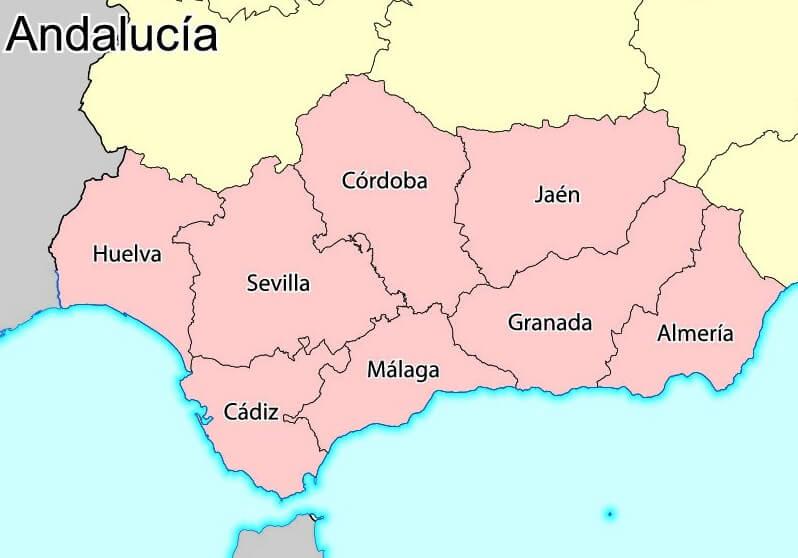
Málaga is one of eight provinces of the autonomous community of Andalusia, and, as we see below, it's divided into nine regions.
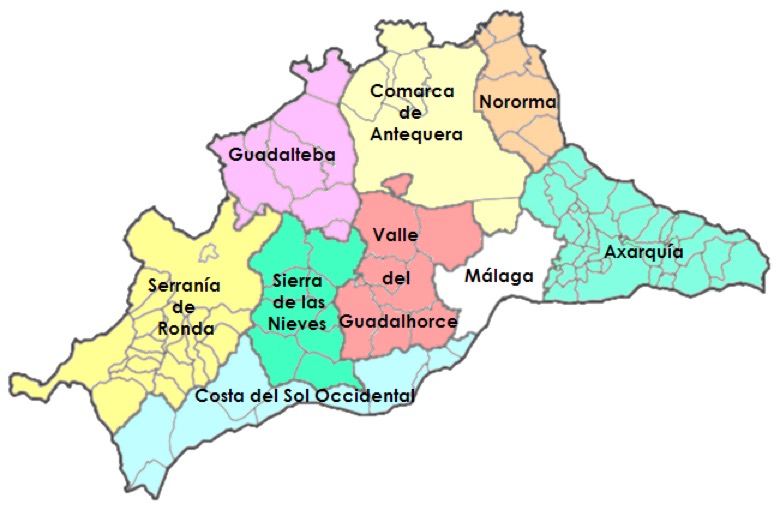
The regions are:-
Comarca Metropolitano de Málaga, which includes the city of Málaga.
Comarca de Antequera with the city of Antequera.
Comarca Nororiental de Málaga (Nororma).
Guadalteba.
La Axarquía with the city of Vélez-Málaga and the towns of Rincón de la Victoria and Nerja.
Valle del Guadalhorce with the towns of Alhaurín de la Torre, Cártama, Alhaurín el Grande, and the city of Coín.
Sierra de las Nieves.
Sierranía de Ronda with the town of Ronda.
Costa dell Sol Occidental with the cities of Marbella and Fuengirola, and the towns of Mijas, Torremolinos, Benalmádena, and Estepona.
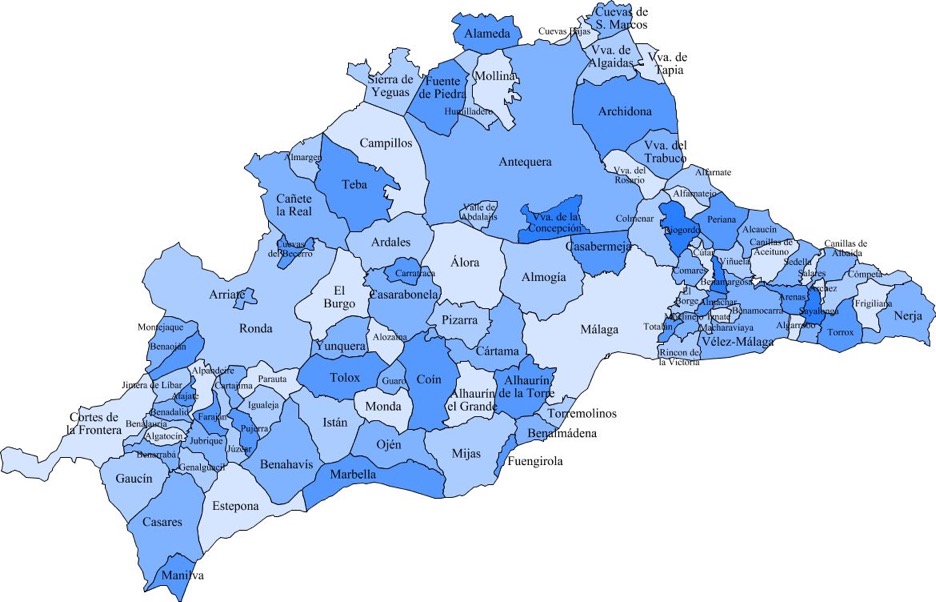
These nine regions group together 103 municipalities. There are 8,124 Spanish municipalities, 778 of them in Andalusia.

Málaga is considered the capital of the Costa del Sol metropolitan area, which has a population of around 1.1 million people.
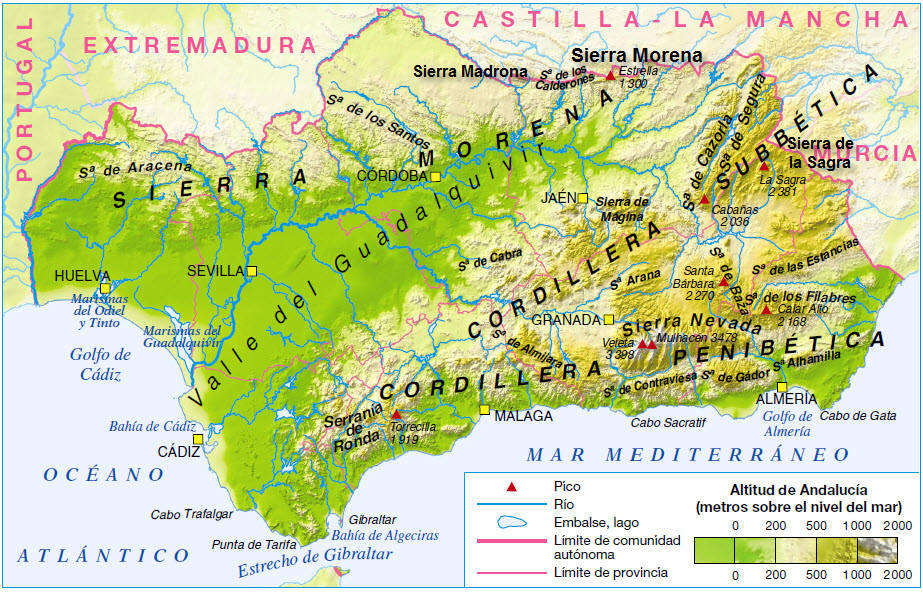
The most obvious physical features of the city and province of Málaga are the Montes de Mâlaga (Málaga Mountains) which are part of the Penibastic System, one of the three mountain ranges in Southern Spain (and including the highest point in the peninsula, Mulhacén with 3,478 m, in the Sierra Nevada). The river Guadalmedina, flows out of the Montes de Mâlaga, and divides Málaga into two parts. It is the Montes de Mâlaga that protects Málaga from cold weather, making it one of the warmest cities in Europe.
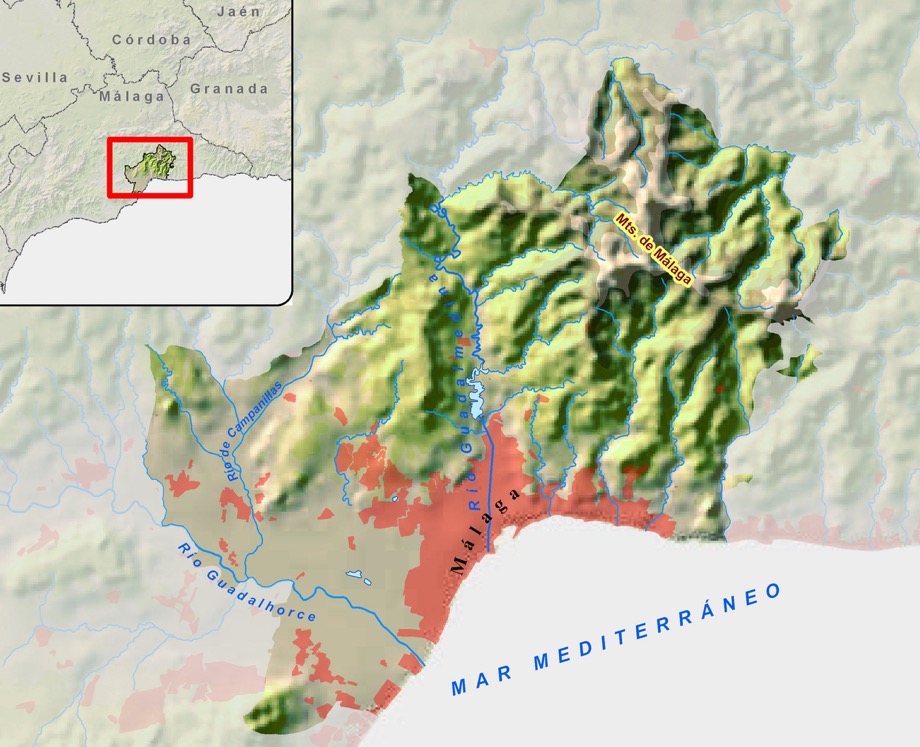
In 2019 more than 19 million people landed at Málaga Airport, but in the 1840’s it was said that Málaga was best seen from the sea “standing in the centre of a wide bay, flanked by lofty mountains, and by picturesque ruins of its ancient fortifications and castle, which cover the hill rising immediately to the East”. However visitors said that the only handsome feature in the city was the Alameda (public walk) with it magnificent public buildings. The rest was a labyrinth of narrow, badly paved, dirty streets. Even in the 1840's, the only building worthy of notice was the Cathedral.
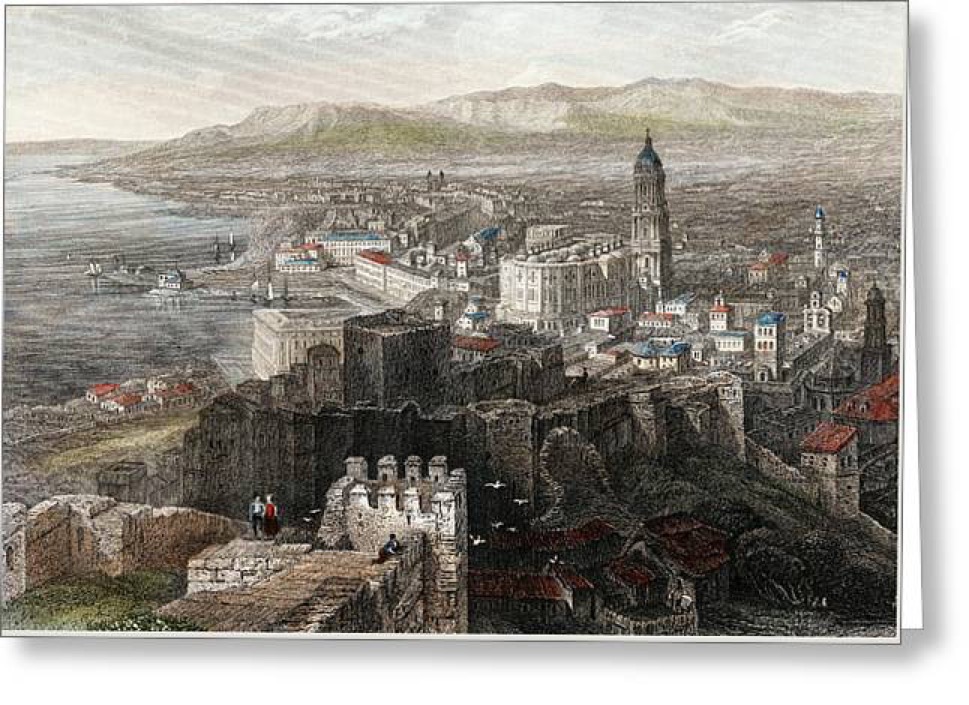
The population was around 65,000, and smuggling was very prevalent. The port could accommodate 450 ships. The city exported wines, raisins, almonds, grapes, figs, lemons, olive oil, brandy, anchovies, cummin-seed, aniseed, as well as soap and lead. Imports were salt-fish, iron hoops, iron-bar, nails, cotton fabrics, hides, earthenware, woollen cloth, butter, cheese, and linen.
In discussing the sweet Málaga wines, it was noted that labour was cheep at 2 1/2 reales a day (that was 4 1/2 pence). In the 1840's the US was already emerging as the major export market. At this time the Málaga Muscatel raisins were considered the best in the world.
Málaga manufactured linen and woollen cloth, sail-cloth, ropes, paper, leather, hats, soap, cigars, all on a limited scale. One travel guide noted that the fisheries gave employment to the “lower classes”. The fruit market was the best in Spain, and a barrel of anchovies would cost only 2 reales (about 4 pence). Bread and eggs were expensive, but fish, melon, pomegranates and the local wines were so cheap that they appeared to cost nothing.
In a telling analysis it was said that the people of Málaga were more Moorish than those of Seville, and “afforded innumerable pictures of idleness”. Hundreds of people doing nothing, sitting on the ground, lolling against walls, begging and thieving (crime went almost unpunished). One observer noted that many criminals had been released from the penal settlement in Ceuta, and most appeared to settle in Málaga.
On the other hand, reports of the time indicated that the “better classes” were friendly and the women were witty and quite showy in dress.
I have used the Wikipedia article on the History of Málaga as a backbone, on to which I have tried to graft a few personal insights.
History of the city of Málaga (770 BC - 1487 AD)

Traditionally the story of Málaga starts in 770 BC when it was founded by the Phoenicians from the city of Tyre (see also this History of Málaga). This makes Málaga one of the oldest cities in the world, and the second oldest city in Spain, after Cádiz.
The story of Málaga might have started in 770 BC or a bit earlier, but we know that paintings found in the Caves of Nerja have been dated to ca. 40,000 BC (the caves are about 60 km away from Málaga). One supposition is that they could have been painted by Neanderthals, because they are thought to have remained in the south of the Iberian Peninsula until ca. 37,000 years ago, 5000 years after they been replaced or assimilated by early modern humans elsewhere in Europe. It would appear that the caves were lived in year-round about 19,000 years ago. We know that tool-makers of the Solutrean industry occupied the Cueva de la Pileta in the Málaga region sometime between 20,000-15,000 BC, and that they were replaced by the Magdalenian cultures (15,000-10,000 BC). We should not forget that the Iberian Peninsula saw substantial human population movements during prehistoric periods as a periglacial refugium for hunter-gatherers from northern latitudes. However, Andalucía was probably one of the last part of the continent reached by these migrations.
Sometime between 6000-5000 BC Andalucía experiences the arrival of the first agriculturalists, and the first dolmen tombs began to be built ca. 4800 BC. There is some evidence that a form of pottery appeared about the same time, i.e. La Almagra pottery has been dated to as early as 5300-5000 BC. There are indications that the Iberian Peninsula saw two independent migrations, probably from two slightly different source populations following different routes into the peninsula, i.e. an earlier farming/pastoral migration and a later central European steppe-related migration. And it looks as if those migrations did rapidly extend down to Andalucía. However, the region would have to wait some considerable time for early metallurgy to filter down to it from northern Spain, e.g. the Bronze Age is said to arrived with the El Argar civilisation in Los Miliares (near Almeria) ca. 1800 BC.
The Phoenicians were traders, and they built trading posts all over the southern Mediterranean, from Carthage to Gibraltar, and including Malaka on the mouth of the Guadalmedina (Malaḥa or mlḥ probably derives from the Phoenician word for "salt" because fish was salted near the harbour). It is thought that they first established a small trading harbour on an islet of the River Guadalhorce (now silted over). Gradually the trading colony moved to the mainland, establishing Malaka. Experts think that Malaka had already become a vibrant commercial centre by the 8th C BC. There are indications that the Phoenicians discovered off the coast murex sea snails, which was the source of the famed Tyrian purple.
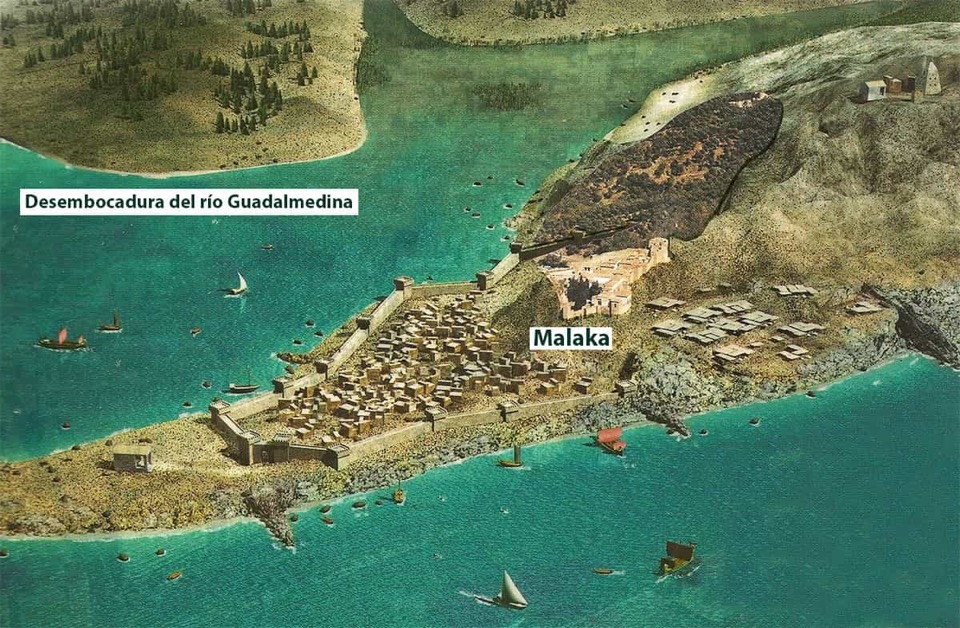
The Phoenician’s were already well established in Gadir (Cádiz), and they also founded Sexi (Almuñécar) and Abdera (which later became an important Roman town in Hispania Baetica). The Phoenician necropolis Trayamar and the remains found in the Morro de Mezquitilla (both near Algarrobo) are some of the most important Phoenician remains in western Europe (check out this for a detailed description of the Morro de Mezquitilla site). Additional remains have been found in Chorreras (also near Algarrobo), in Los Toscanos (near Vélez-Málaga), and in the necropolis Almuñécar. Necropolii show the evolution of Phoenician burial customs from cremation to burial. The tombs themselves were dug underground, walled with stone blocks and wooden columns and a gable, and accessed through a corridor sealed with stones. Vaults were reused, and probably were specific to families. It looks as if a ritual feast was held inside the tomb, and the crockery used was left inside.
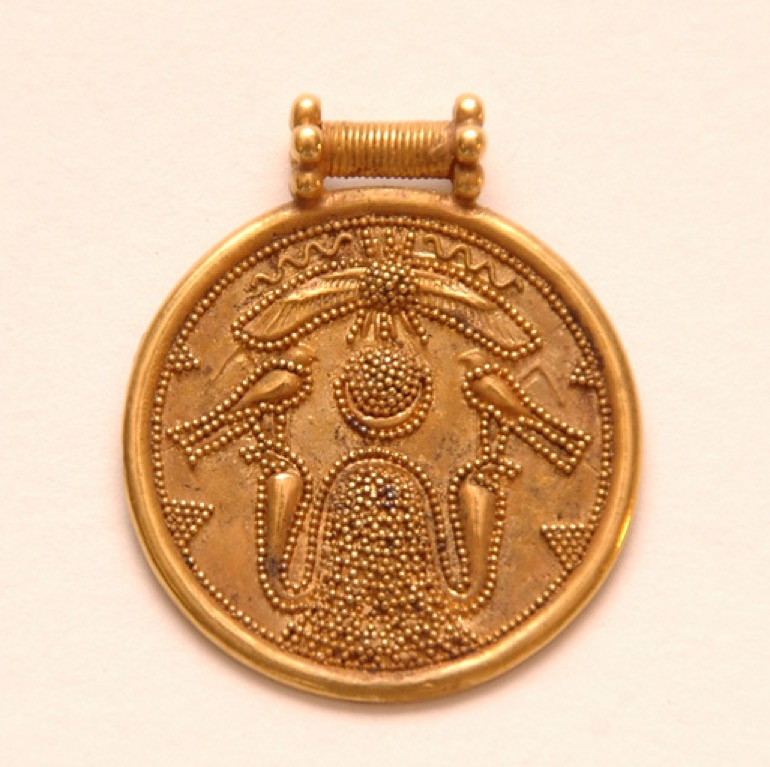
Above we have the Trayamar Medallion, found in the Phoenician burial ground in Trayamar, near Morro de Mezquitilla. The motif is Egyptian, the material embossed gold, and it has been dated to the 7th C BC. What we see are two cobras emerging from a mountain of sacred stones (possibly Baetylus, and representing the house of God), with two perched falcons. Above them we see Horus with open wings, and a sun/star and crescent moon, symbols of Astarte-Tanit (goddess of life and death). This can be found in the Museo de Málaga.

Above we have a so-called “boca de seta” (mushroom neck) jug, dated to 8th C BC. This Phoenician container would have been used for wine or perfume. There is ample evidence that the Morro de Mezquitilla site was built over an earlier Copper Age village, abandoned during the Bronze Age, and then re-occupied by the Phoenicians. The Museo de Málaga has five of these jugs in its collection.
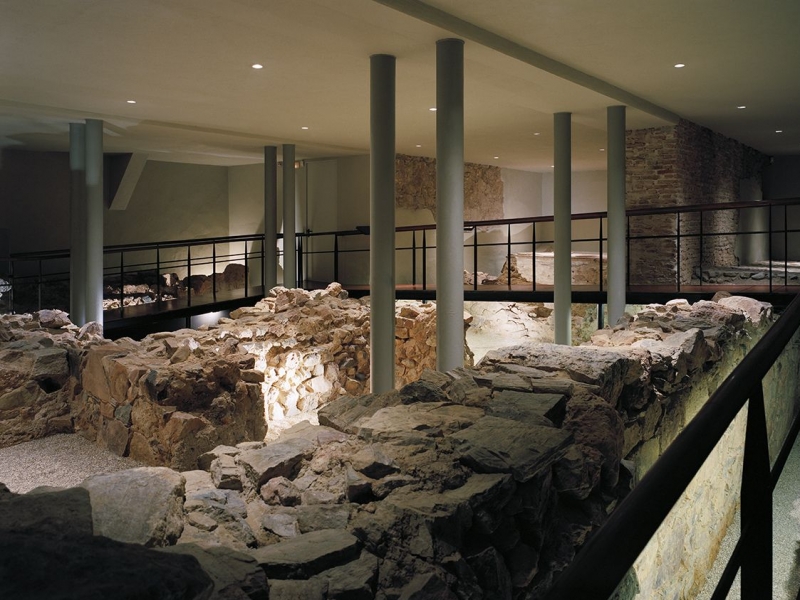
During the restoration of the Palacio de Buenavista to house the Museo Picasso Málaga, the original Phoenician walls were discovered.
In 573 BC Malaka became a colony of the Punic Empire of Carthage, and to mark their domination they also sent settlers. The connection between Malaka and Tyre gradually shifted to Carthage from the mid-6th C BC. With the arrival of the Magonid dynasty in 550 BC Punic foreign policy became more aggressive against the Greek presence in the western Mediterranean. After some setbacks, by 480 BC they had managed to close the Strait of Gibraltar to Greek shipping. Carthage proceeded to destroy Tartessos and drive the Greeks from southern Iberia. In the 3rd C BC, Carthage occupied most of Andalusia and in 228 BC they re-founded Cartagena as a based for their conquest of the whole of Spain.

In 2012 an intact tomb was found just outside the ancients walls of Malaka. It contained both a medium-sized man and a Greek soldier. Above we have soldiers helmet dating from the 4th C BC.
The situation of the Iberian Peninsula before the Roman invasion is described by both Greek and Roman historians or geographers who often lived quite sometime later, e.g. Strabo (Greek, 63 BC to 24 AD), Pliny the Elder (Roman, 23-79 AD), etc. Occasionally reference is made to Avieno, a Latin poet of 4th C AD, who described the voyage of sailor from Massalia in 530 BC. Generally it would appear that the Romans considered the local population either Celts of the plateau or Iberians on the coast. However a variety of indigenous tribes of the south of the peninsula have been mentioned, most notably the Mastieos (also later called Bastetanos), the Libiofenicios (possibly Libyans occupying local territory), and Turdetanos. After the Carthaginian presence in the south of the peninsula, almost all the names of the tribes were latinised by the different authors, and the Bastetans and Oretans appeared to be the most important tribes (for further information check out this publication and have a look at this list of pre-Roman peoples on the peninsula).
Below we have a view of the southern part of the peninsula, with pre-Roman, indigenous cities and colonies that were issuing coins before 45 BC. We can see the various linguistic groups as well as the lines of Roman occupation for 194 BC and 156 BC.

Malaka became part of the Roman Empire after the Punic Wars in 218 BC. In its Roman period, the city (Latin name, Malaca) showed a remarkable degree of development. Transformed into a confederated city, it was under a special law, the Lex Flavia Malacitana.
We should not ignore the fact that before Rome arrived the different peoples and tribes in the peninsula engages in intense diplomatic exchanges that required a formalised system of relationships, usually modelled on interpersonal relationships such as brotherhood and parent/child relations. Kings of equal standing were 'brothers', and subordinate relationships were often called 'farther' and 'son'. 'Brotherhood and love' was used to express peace and friendship (and this was later denoted as 'amicitia et societas' by the Romans). It was the Greeks that first introduced the idea of a relationship of hospitality and protection that might bind a new member in a community. It was in the 6th C BC that the Greeks increasingly favoured business contacts in the Mediterranean area, reinforcing those alliances in a defensive or offensive treaty. This went beyond a military alliance and created a 'good relationship'. In the 3rd C BC Rome built its domination on military alliances by treaties of 'societas' (socii). However, the idea is that Rome quickly understood the established relationships between peoples in the peninsula that were based on exchange and a sharing of cultural models. They quickly adopted a kind of 'informal association' with the word 'amicitia'. Later Rome's domination could be seen as placing its friends as subservient dependents, but they retained the Greek tradition of 'amicitia'. With time Rome reinterpreted the international models of relationships. 'Amicitia' because a state of good relations, even without a treaty. 'Foedus', or friendship, was a ritualisation of those good relations, but it could have several different forms. One might be the end of hostilities (winner or loser), another might be concerning a military-oriented alliance ('foedera amicitiae causa'). There were provisions when a winner might accept that the adversary showed valour, and that an original position might be restored to benefit both parties. Then there were treaties of friendship, not based on a conflict. This 'foedus' was defined as a 'sociale foedus' pact of friendship, a requirement of 'amicitia'.
At the end of the day a treaty with the all powerful Rome might be an open friendship, but at best it was similar to a client, whilst retaining his freedom, honours his patron.
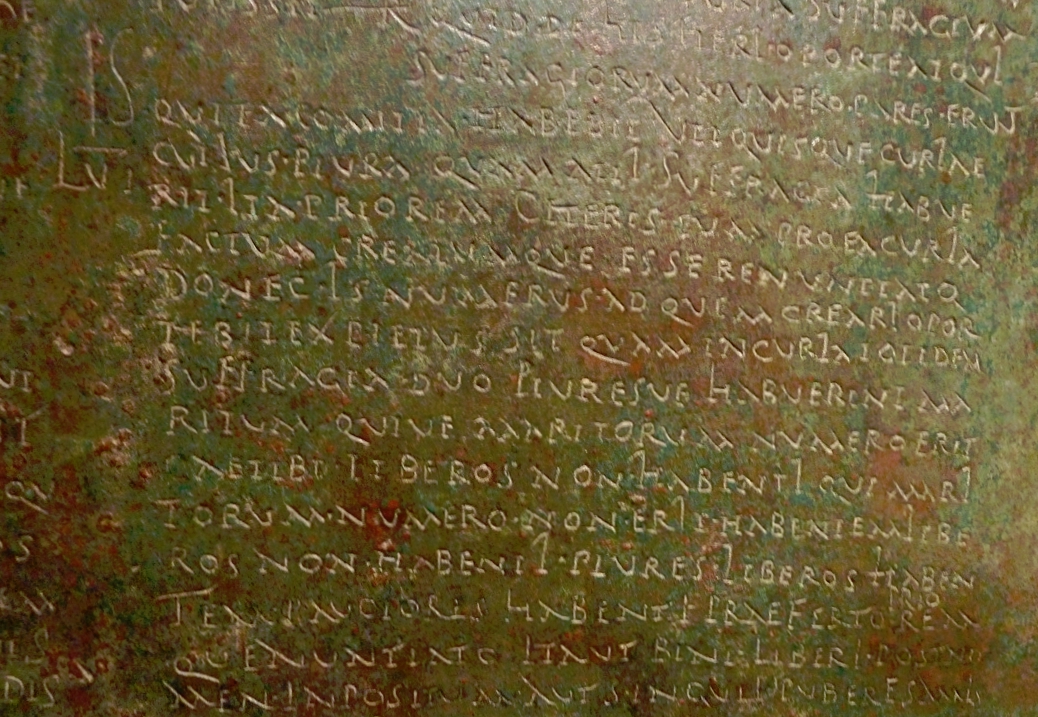
The Lex Flavia Malacitana are described in two large bronze sheets (89 cm by 122 cm) dating from 74 AD, and found in Málaga in 1851 (they would probably have been part of a series of five sheets). The discovery was said to have been the first time we have found originals of Roman municipal laws.
By 74 AD Málaga had become completely Romanised (or Latinised), and at that time was part of Hispania Baetica. In 69 AD a civil war broke out in Rome (the so-called Year of the Four Emperors) terminating with the accession of Vespasian (9-79 AD), first of the Imperial Flavian dynasty. Already there had emerged a kind of Romanised elite in Baetica that ensured stability.
We should not forget that both Trajan (53-117 AD) and Hadrian (76-138 AD) came from Baetian stock. Below we have a bust of Trajan that can be seen in the Museo de Málaga.
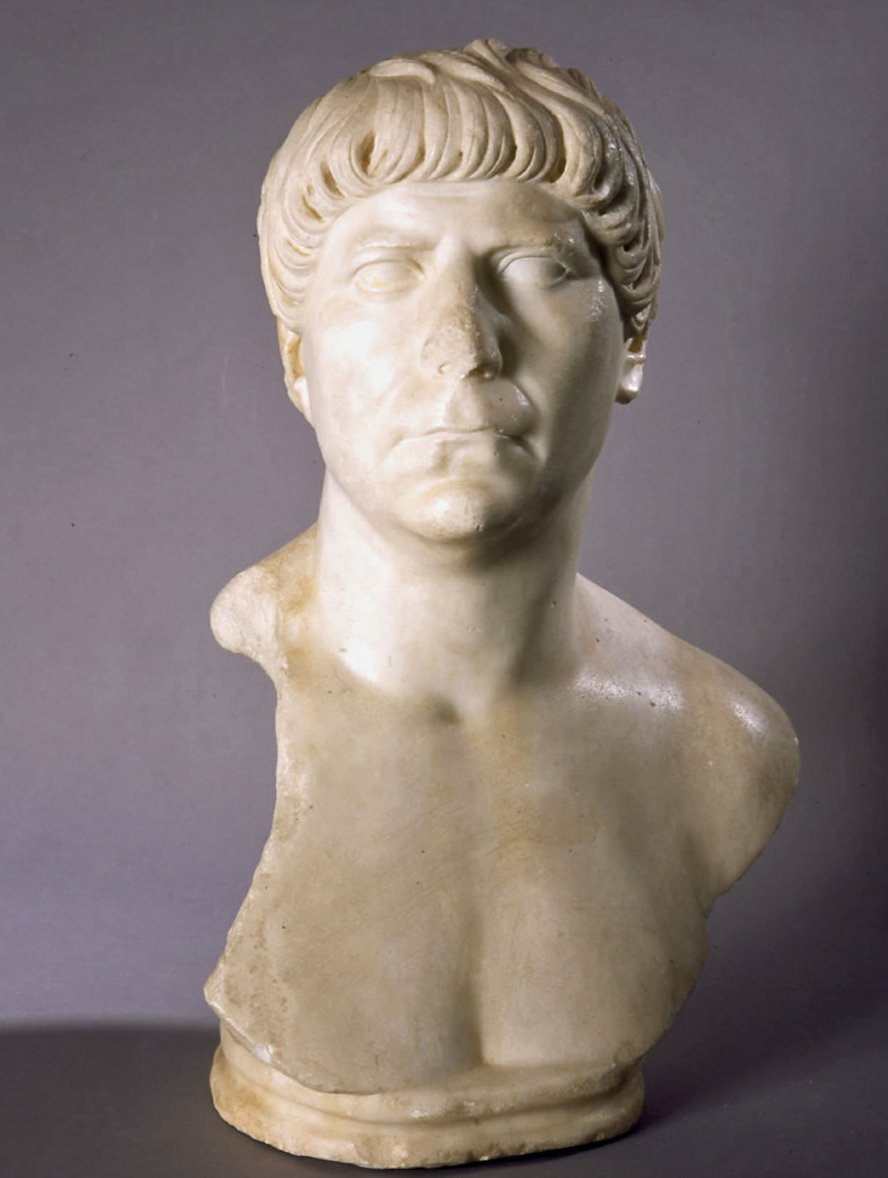
This type of idealised representation was essentially a 'political' tool designed to project a sense of resoluteness, fortitude, decisiveness, and above all stability.
Málaga was not one of the four major centres of power in the region (Cádiz, Córdoba, Écija and Sevilla), but its port is known to have shipped olive oil to every part of the Roman Empire. Vespasian granted ius latinum (Latin rights including civic status) to inhabitants of Hispania (thus ensuring support from the elite and middle classes).
It was Vespasian that also granted Lex Flavia Malacitana in 74 AD (along with grants across the whole of Hispania), although they only came into effect sometime between 81 and 96 AD, during the reign of Emperor Domitian (51-96 AD).
Only headings (rúbicas) 51-69 were found (parts 51 to 66 are from the ius latinum), and they treat election procedures and the voting for judges by popular assemblies, the appointment of municipal employers, rules for managing public funds, and how obligations and rights are distributed according to the economic capacity of the individuals. The depth of detail was quite impressive, for example it is stated that owners of destroyed buildings should rebuild within one year or face a fine, and that the start date for rebuilding must be posted on the street.
More specifically to Málaga there is also mention of the way to deal with the returning of funds taken from municipal funds, and the accountability to be applied for business events paid by public funds. Málaga could also nominate local councillors without taking into account imperial appointments.

The Roman Theatre is the most obvious Roman vestige in the city, and is one of 7 preserved Roman theatre’s in Andalusia. It was built during the 1st C AD, and was used for at least 200 years. It then fell into disuse, until the Arabs used it as a quarry for building the adjacent fortress. The theatre was rediscovered in 1951 during some excavations, and it has now been restored.
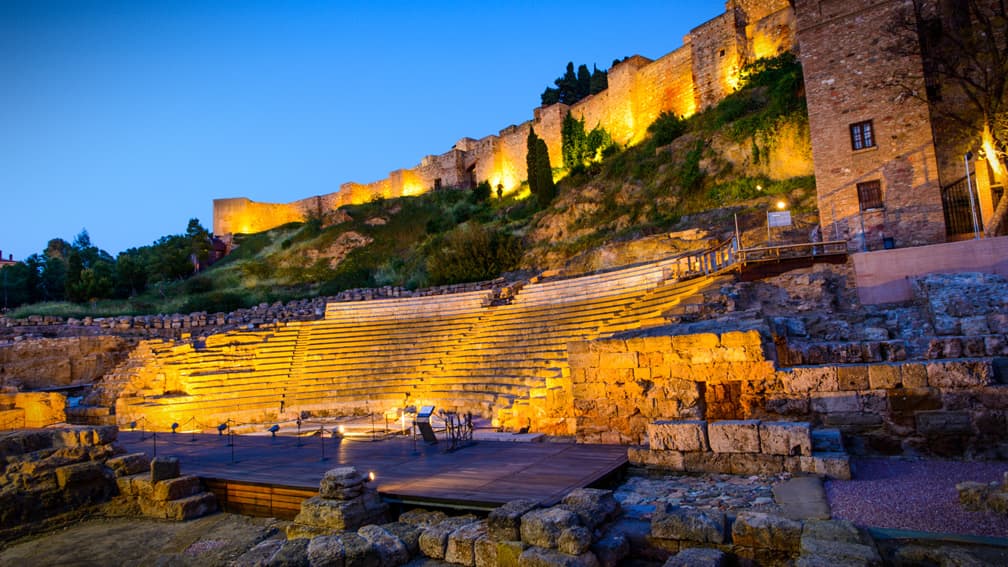
The three clearly defined areas of a Roman theatre can easily be seen. The stage, the orchestra where the local authorities sat on white marble seats, and the 13 rows of seats set in a perfect semi-circle around the stage.
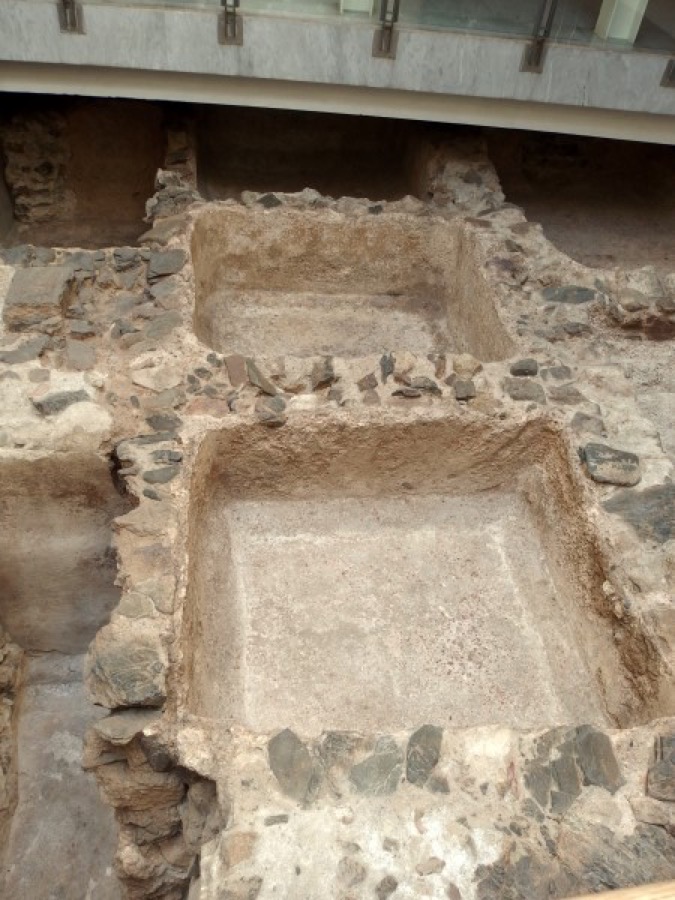
Málaga was well known for its salted fish, and so it was “easy” for everyone to make garum, a fermented fish sauce used by Romans as a condiment. It was such a delicacy that anyone who produced it or traded it would become rich, and the best garum came from Baetica. Garum factories were all over Málaga town (see the garum stone vats above).
We know that Málaga shipped to Rome ceramics, almonds, wine, oil and fish prepared with garum. It was an important and rich town, and it's not surprising that they built a defensive wall along the coast. However, it did not stop the Vandals arriving around 411 AD.
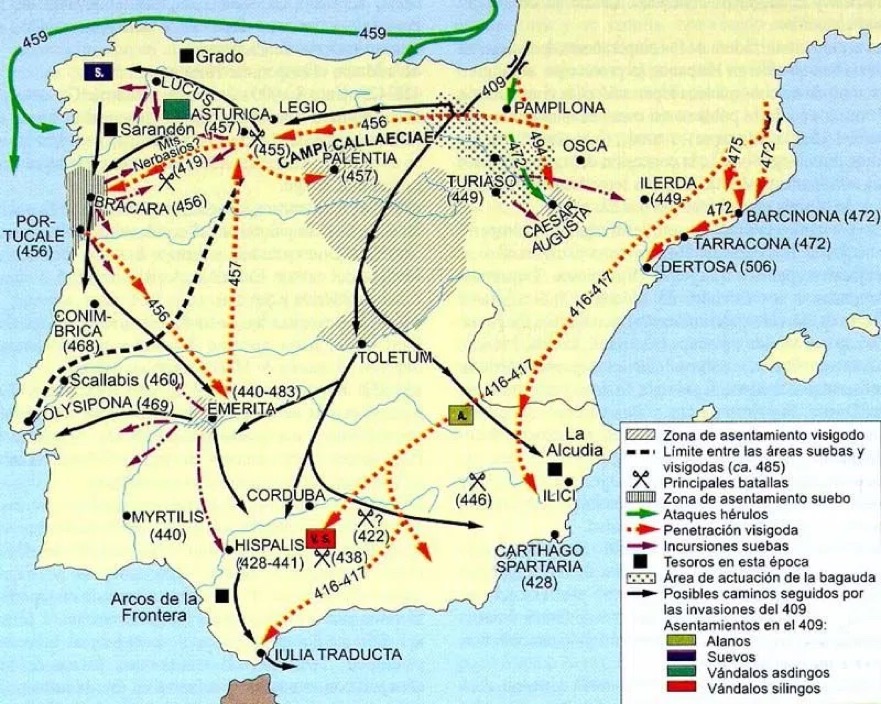
And a few years later, the Visigoths became the new 'owners' of Málaga. Fighting between the Visigoth kings allowed the Byzantine occupation of the region for just over a century. In the early 7th C AD, the Visigoths recover their territories until the Muslim invasion. Both the Visigoths and the Byzantines had continued and consolidated Málaga as a trading port.
By 714 the Moorish invaders ruled over Spain, including Málaga which they called Mālaqa. The indigenous population fled into the mountains, and the city was settled by Arabs and Berbers. It took more than 200 years for the region to regain its economic and social importance.

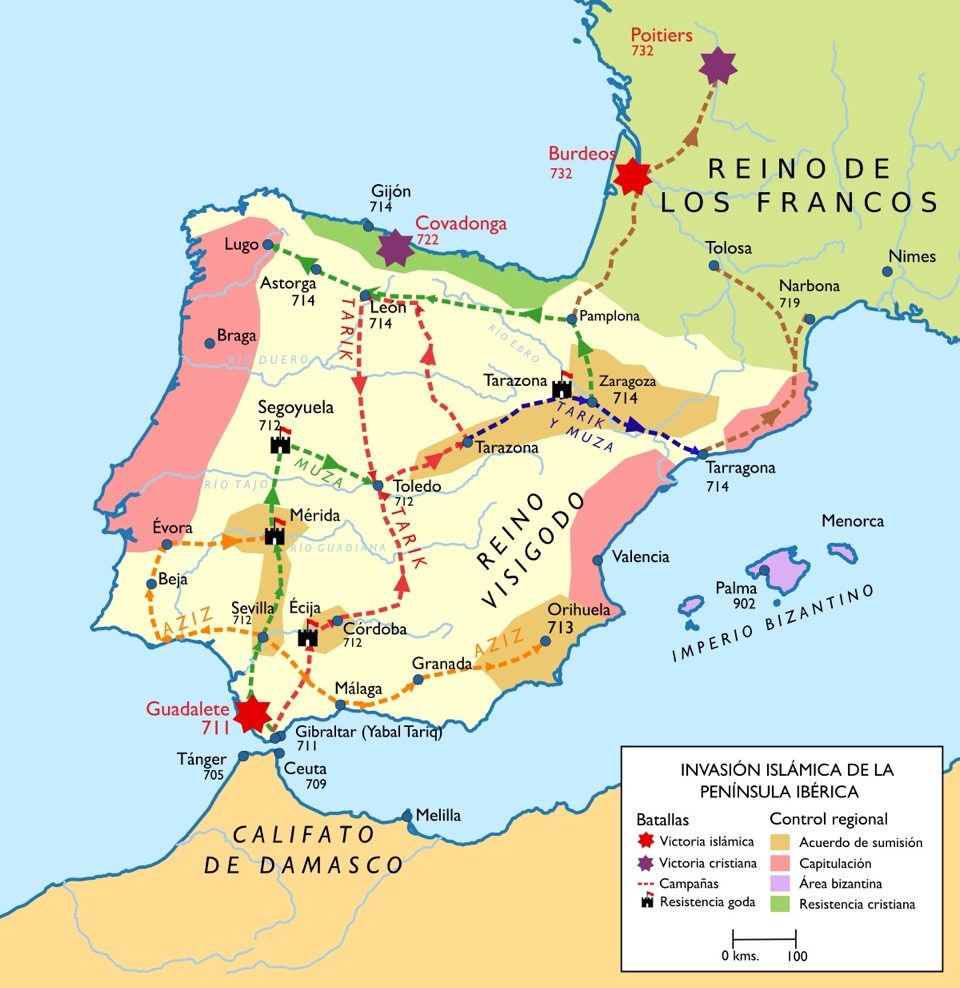
It was in 928 that Abd-al-Rahmān III (889-961 AD) imposed an Islamic system of civil organisation on the region. The urban areas developed with artisanry, and trade and farming in rural areas benefited from intensive irrigation-based agriculture. Málaga became a Moorish citadel with a walled enclosure, a port with Nasrid shipyards, and a Alcazaba (a fortified centre) on Mount Gibralfaro. Areas of the city were settled by Genoese and Jewish merchants, and one writer even called Málaga a “Paradise City”.
At this time Mālaqa stretched between the Alcazaba (sometime written Al-Cazaba), the residence of the governor and including a mosque, and the water stream known as the Guadalmedina (Wadi al-Madina). To the west stretched a fertile plain covered in various crops and especially tropical fruit. Along the coast in both directions there were fig plantations. Further back there were groves of oranges and pomegranates, and there were grapevines producing grapes that were considered the most luscious of Muslim Spain. Almost all the medieval geographers of Muslim Spain were enthusiastic about Mālaqa. They praised the elegance of the population, the liveliness of its streets, and the beauty of its buildings. The great mosque came if for praise, and did the wrong and thick walls. Many noted that the city was strikingly Oriental, with narrow streets often covered with awnings, many arches, well organised bazaars, good baths, and always a long string of camels carrying a variety of merchandise. Mālaqa was immediately appreciated by the Genoese in part because of the immense traffic in the port, and in part by the tolerant attitude of the Muslims in assigning a suburb for their enterprises.
One noble of the time wrote
"Mālaqa indeed bestows life with tis figs, but also causes death by them.
During my illness my physician forbade me to eat them.
How little does he care for my life"
It was said that figs from Mālaqa were prized even in India and China because of their taste and ability to persevere their taste for over the full year's travel necessary for their transport. Glazed and glider ceramics from Mālaqa were unique, and it anchovies were considered special. Silk was a thriving industry, and Mālaqa was famous for the colours and patterns. Interestingly the glaze can be traced because of its specific chemical composition, so we know that it was introduced to Mālaqa in the early 10th century, then travelled to Murcia before the going to Valencia in the early 14th century and to Barcelona at the end of the 14th century. The kilns that were used in Spain, and are still used today, originate in the Middle East. They had defined four different ovens, of increasing temperature, with the 'slow-heater", then the baker's oven, then the potter's furnace, and finally the glassmakers oven. Glass blowing and cutting was well known in Mālaqa, Almería and Murcia, and was cut glass. However Muslim Spain started to disappear with Córdoba in 1236, Valencia in 1238, Murcia 1266, and Seville in 1248, only the enclave of Grenada remained, with Mālaqa, until 1492.
In 1026 Mālaqa became the capital of the Taifa of Málaga (1026-1239), an independent Muslim kingdom. Its independence went through four distinct periods. It was ruled by the Hammadid dynasty as part of the Cora de Rayya of the Caliphate of Córdoba from 1026 to 1057. Then it was part of the Ziríd dynasty from 1073 to 1090. There followed a period of self-rule with Banu Hassun from 1145 to 1153 and the Banu Zanum from 1229 to 1239. And finally it was conquered by the Nasrid Kingdom of Granada.
With the trading agreement of 1279 between Muhammad ibn Nasr (1194-1273) and the Republic of Genoa, Málaga became again one of the busiest ports in the Mediterranean. By 1278 Málaga was shipping barley, nuts, wine, wool, silk fabrics, lacquer, leather, skins, etc. to Flanders and England. With imports such as perfumes, gold, spices, cotton, etc. Málaga became the door of the Kingdom of Granada and the link between the Mediterranean, the Atlantic and the North Sea. It gradually evolved as a centre of shipbuilding and international trade. Mālaqa (Málaga) remained under the rule of the Nasrid dynasty till the Reconquista of the Catholic Monarchs (1492). By 1445 Málaga was an important part of a regional and international trade network, established by the Genoese as a cooperative institution known as consulados (consulates) to connect merchants.
The Mālaqa shipyards, the Atarazanas, were built during the reign (1354–1391) of Mohammed V of Granada to strengthen his political and military power. Constructed as a naval workshop, the main building was one of Mālaqa's largest and most impressive, and was noted for its seven monumental horseshoe arches. During this period the coast was further inland and the Atarazanas were at the edge of the sea. In fact the shipyards were so low that the water flowed in and formed a basin capacious enough to contain 20 galleys. The walls around it were around 25 m high, and the arches, for the reception of ships, were 20 m high by 10 m wide, and 4 m thick, and each of these arches had its own gate. Málaga was best known for building light ships for patrolling the coast.
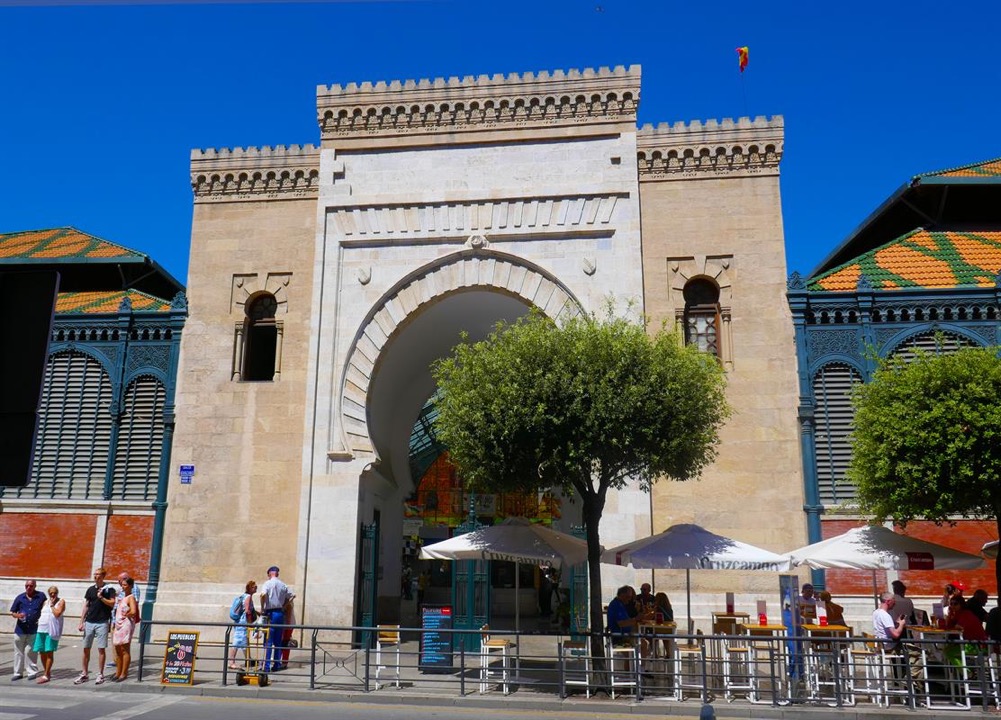
The Atarazanas market is in the place where the Nasrid shipyards stood until the 14th C and which, after the Christian conquest of the city, were used for storage and as an arsenal, military hospital and barracks. In 1868 it was decided to demolish the shipyards to give work "to the poorer classes", and build a new market, the Alfonso XII Market, in its place. Fortunately it was finally decided to keep the ancient monumental door to the old shipyards and place it in the centre of the main façade of the new building.
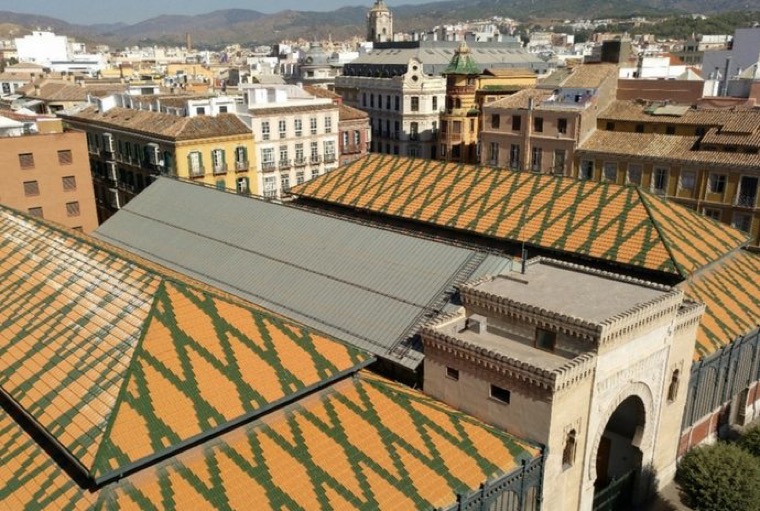
The architect Joaquin Rucoba designed the market it in a neo-Arab style, although using a great deal of glass and iron. The market opened its doors to the public in 1879, and after being renovated between 2008 and 2010, is certainly one of the city’s top tourist attractions.
A German traveller in 1494 admired the shipyards for their facilities for repairing ships, with new ships being built at the adjacent quays. At the time the shipyards were one of the biggest and most important of its kind in the world, and it was an immense store of naval supplies and munitions of war.
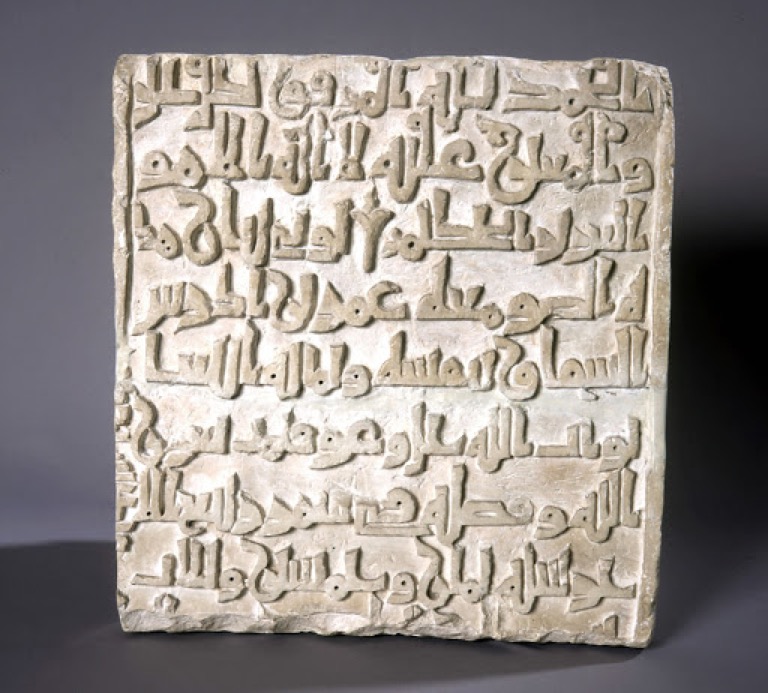
Above we have a unique commemorative plaque dating from 969 AD. The text is of an individual addressing God, saying that he has built a minaret with “his own will and his own money”, and that he would "await for the reward of God" for "God favours every act of good". This can be seen in the Museo de Málaga.
During the occupation of Al Andalus (Muslim Spain) Málaga became a centre for Islamic pottery, more specifically Hispano-Moresque ware. The Moors introduced both glazing with an opaque white tin-glaze, and lustreware, which imitated metallic finishes. Until 1450 Málaga was a major centre for Islamic-style decorated pottery. By 1492 the most important pottery factories had moved to Manises, near Valencia, from where they continued to export ceramics all over Europe.

Fine ceramics made in Mālaqa were frequently given as diplomatic gifts, and we know Eleanor of Castile received earthenware from Málaga in 1289 when she was queen consort of Edward I of England. Italy was passionate about Hispano-Moresque pottery, and started in the 13th C to massively import it through Majorca, a central Italy-Spain trading hub. From the 13th C Italian potters had been studying and copying the Hispano-Moresque ceramics, which they called majolicas, first strictly meaning lustreware, then tin-glazed earthenware in general. Their technique was constantly improved, laying the ground for the Italian Majolicas that became so popular during the Renaissance.
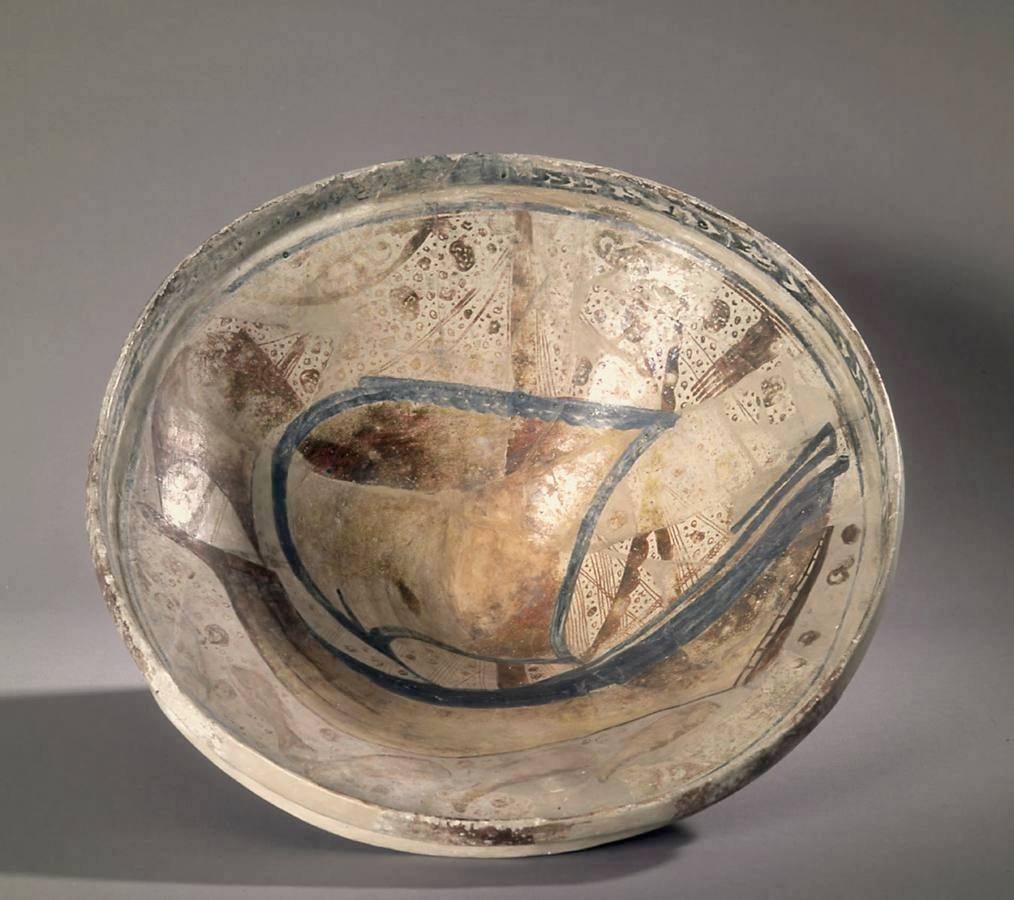
The second example above is the famous “loza dorata”, a golden amber yellow lustreware, from Málaga. This particular example, using the shape of the bowl to highlight the shape of the hull and sails, is very rare. Usually the decoration was nature inspired or geometric. The technique itself is said to derive from Persia, via Egypt.
Moorish potters applied a tin-glaze over a design usually traced in cobalt blue. After the second firing a lustre glaze made with silver and copper pigments was applied by brush over the tin-glaze and the piece was fired again. This splendid finish was first experimented to overcome a very practical issue. The Holy Qur’an forbade the use of precious materials on the table, but “loza dorata” looked precious but was made of ordinary materials.

The third item, a tray for washing, was made in Málaga, and can be found in the Museo de Málaga. It dates from the 13th C and was probably used for washing at the entrance to a mosque.
By the 15th C about 15,000 people lived in Mālaqa, most of them were Muslims strictly observant of religious orthodoxy as taught by the Fuqahā', the expert jurists of Islamic law. There was a sizeable minority of Jews, while the presence of Christians was reduced to those captives taken in war, enslaved, and forced to labour in the shipyards. The small colony of foreign traders were mostly Genoese. The governor of the city was typically a Moorish prince serving as a representative of the Sultan, and he resided in the Alcazaba (see below) with his retinue of personal secretaries and lawyers. The large massive city walls, with their many towers, monumental gates and moat, all surmounted by the fortress of Gibralfaro, made the defences of the city nearly impregnable.

Most written sources mention the construction of the walls in the 11th century, however documentary and archaeological evidence really only starts with the period of the Almohad Caliphate (early 13th century). For examples, we now know where in the city sandstone blocks were both cut and used, and line of the costal fortress wall as the city expanded to the sea, along with the some of the structures dedicated to port activities located outside the walls.
The mountainous terrain around Mālaqa did not favour agriculture, but the Muslim peasants organised an efficient irrigation system, and with their simple tools were able to grow crops on the slopes. Spring wheat was their staple diet. An unusual feature of Mālaqi viticulture was the interplanting of grape vines and fig trees, grown mostly in the Axarquía area east of Mālaqa. The raising of livestock played only a secondary role in the local economy. The production of olives was low, and olive oil was often imported from the Aljarafe. Other fruit and nut trees, such as figs, hazelnuts, walnuts, chestnuts and almonds were abundant and provided important winter foodstuffs, as did the mulberry trees introduced by the Arabs, their fruit being used to make juice. Trade in hides and skins and leather working was a major industry in Mālaqa, as was metal-smithing, especially of knives and scissors. We have already mentioned that gold inlaid ceramics and porcelain were also important to the economy of Mālaqa.
A 14th century Maroccan travel wrote "Malaga is one of the principal cities of Andalus, It has an excellent territory, and abounds in fruits of all sorts. I saw once eight ratl of grapes sold in its market for a small dirhem;,the celebrated pomegranate named al-Mursi, and another kind called Al-Yacoti (the rubi coloured) grow on its soil. Figs and almonds form a considerable staple of trade, and are exported in great quantities to distant countries in the East and West, as also its golden pottery, which is quite wonderful. It has a large mosque, Jami, very much renowned for its sanctity, with a very fine open court, all planted with orange trees".
In 1348, while the black plague ravaged Europe, the Moorish citadel Alcazaba and the castle of Gibralfaro took their final shape. The city had several gates that allowed passage through the walls, for example the Puerta Oscura (Dark Gate) and the Puerta del Mar (Sea Gate). The Puerta Oscura was one of the most important gates for those climbing up to castle on Gibralfaro. I’m not sure if there is much to see now, but in 1937 Los Jardines de Puerta Oscura were inaugurated as a series of hillside terraced gardens. Today the Jardines de Pedro Luis Alonso, at the side of the Ayuntamiento, are often (incorrectly) included in Los Jardines de Puerta Oscura.
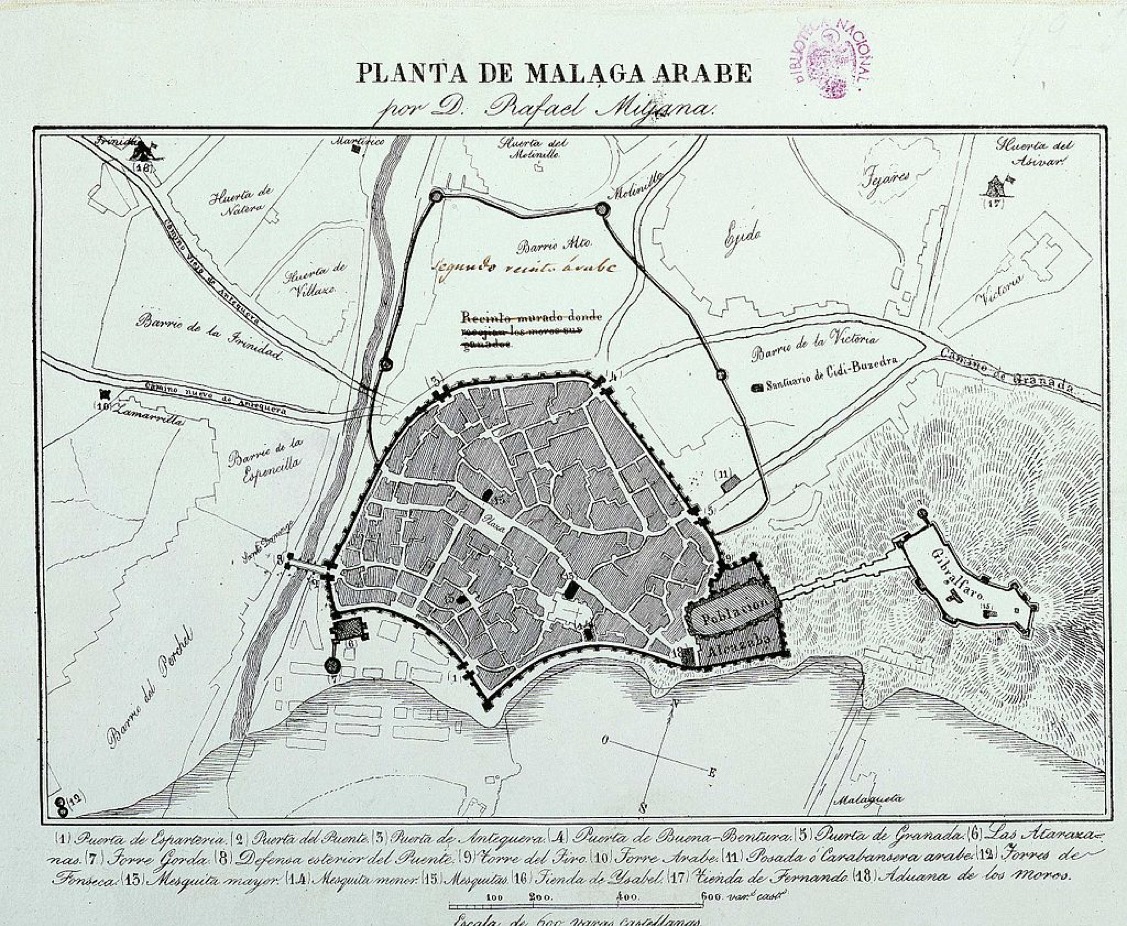
The citadel and the castle were connected by a corridor known as La Coracha between two zig-zagging walls that followed the contours of the land (see below). Erected in the 11th C, the Alcazaba combined defensive fortifications with residential palaces and inner gardens. It was said to have had 110 large towers, and a great number of turrets.
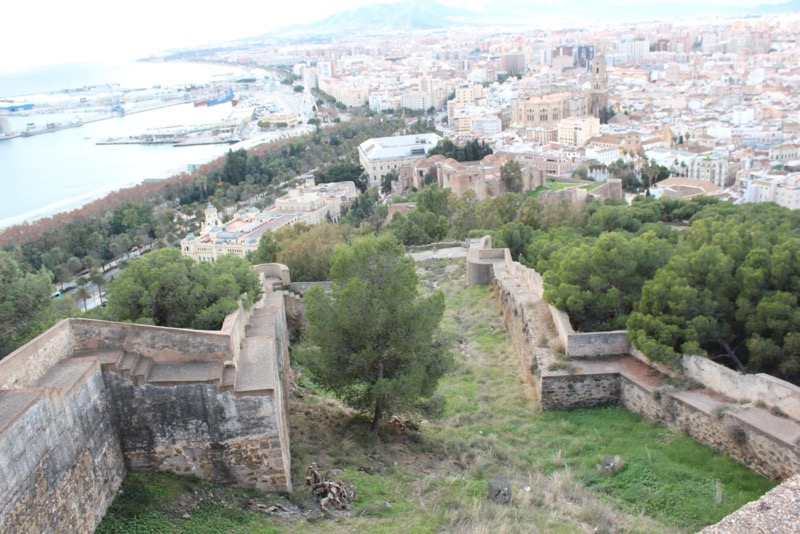
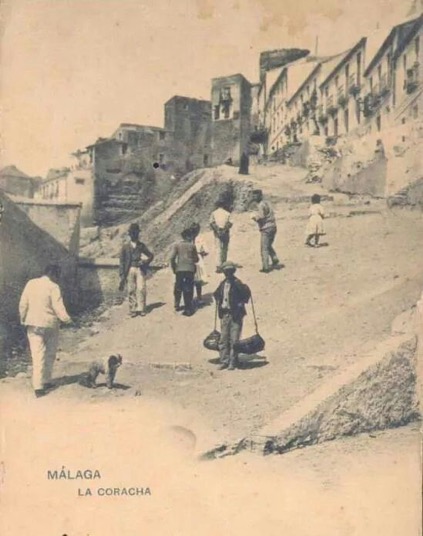
Vimeo, the video community, has a series on Battle Castles, including an interesting 360° view of a reconstruction of Málaga.
Before we move on the Reconquista, let's summarise the situation in Mālaqa. The economic reforms carried out by Muhammad V in the kingdom of Granada during the later part of the 14th century had led to the consolidation of the city's economy. They had an intensive and commercially oriented agriculture, a flourishing artisanal industry and one of the most important ports in the Mediterranean, used by both Muslim and Christian merchants. The economy was heavily dependent upon the Republic of Genoa, whose colony established in the city traded grain from North Africa, oil from Seville and Italy, Cotton from Egypt, and local products such as anchovies and textiles.
The city was divided into specialist areas. Outside the city walls, there was a large commercial and port area located along the coastline between the right bank of the Guadalmedina along to the Alcazaba. The focal point in the city was he Great Mosque, where the commercial district of the Alcaicería was located along with the alhóndigas and souks.
History of the city of Málaga (1487 - 1920)
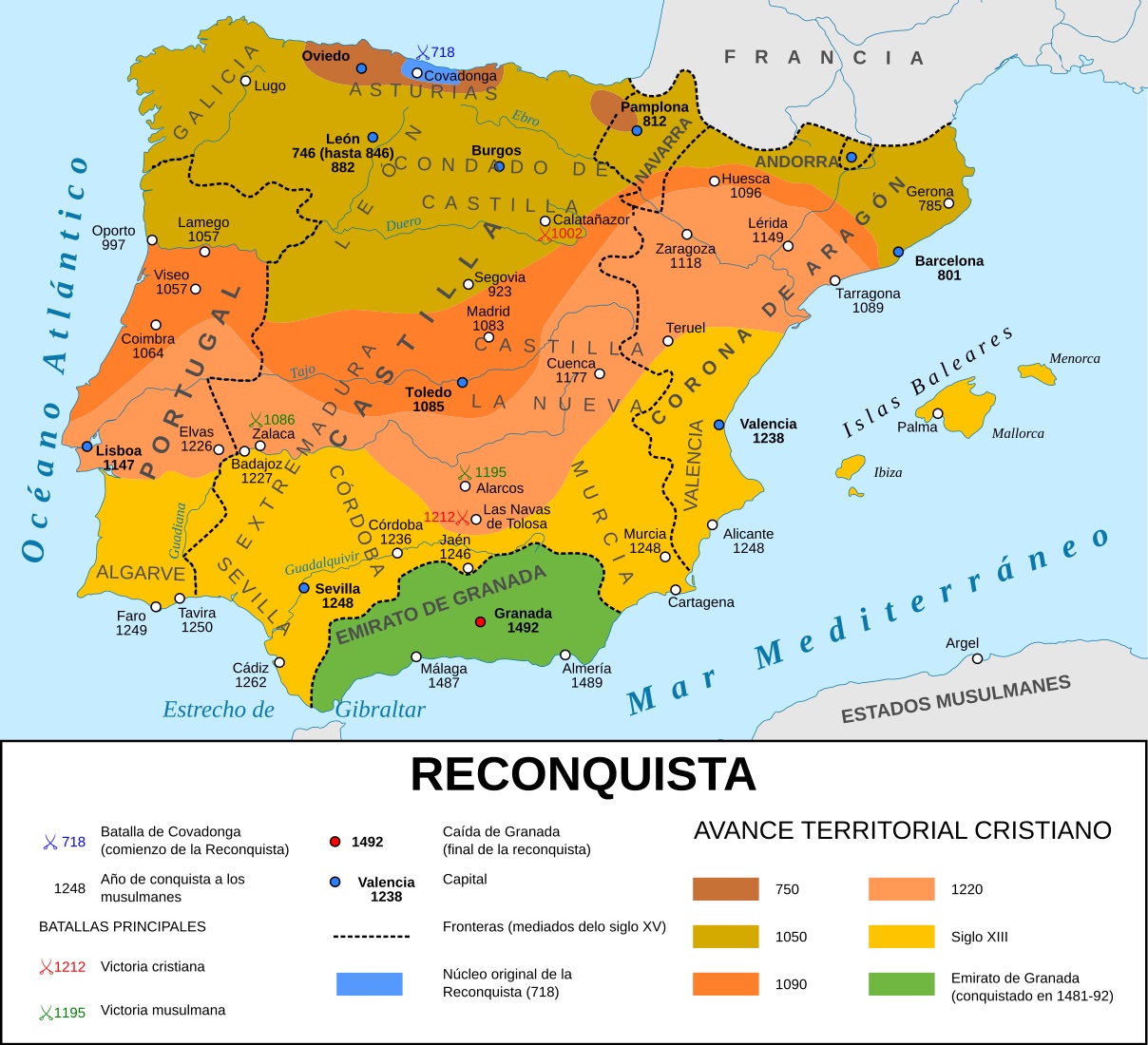
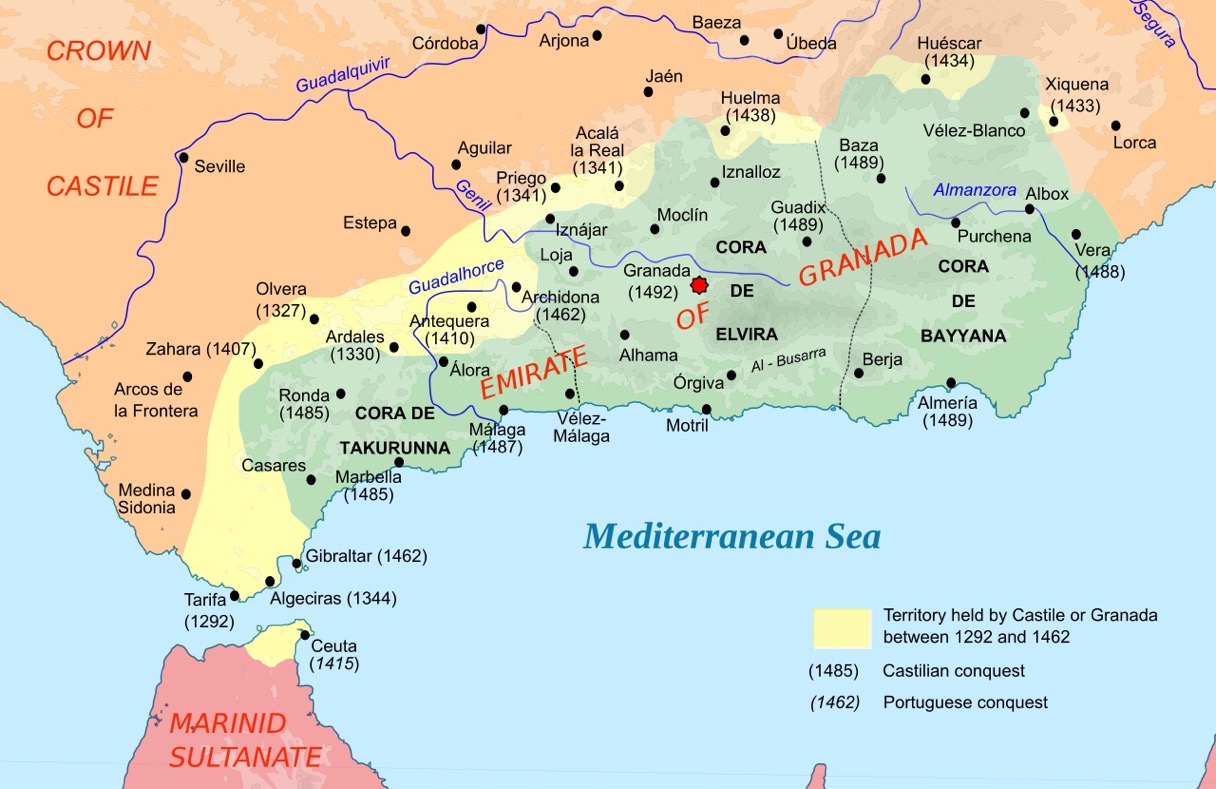
In May 1487 Ferdinand II of Aragon and Isabella I of Castile began their siege of Mālaqa, which after a desperate resistance was finally compelled to surrender. The siege began on May 5, 1487, but the Nasrid troops held out till August. Only the Alcazaba, under the command of the merchant Ali Dordux, and the fortress of the Gibralfaro, under the command of Hamet el Zegrí and Ali Derbal, still resisted. The Catholic Monarchs besieged Mālaqa for six months, one of the longest sieges in the Reconquista. They cut off the supplies of food and water to the city, forcing its Muslim garrison to eventually surrender. On 13 August 1487 the Castilian army, over 45,000 strong, took the city defended by 15,000 African (Magreb) mercenaries and Mālaqi warriors. Because the Moorish chieftain Hamet el Zegrí refused Ferdinand and Isabella's offer of vassalage, they decided not to grant the city an honourable capitulation. The civilian population was punished by enslavement or execution, with the exception of a small number of families allowed to stay as Mudéjar converts in the Moorish compound. The conquest of Mālaqa was the final blow to the Nasrid kingdom of Granada, which lost its principal maritime port. The troops who served in the army of the Spanish victors were paid by the customary division of properties, the repartimientos. Between 5,000 and 6,000 Christians from Extramadura, Leon, Castile, Galicia and the Levante repopulated the province, of which about a thousand settled in the capital, now called by its Castilian name, Málaga.
However, during the latter part of the 15th century the Catholic Monarchs feared a possible alliance between Granada and the Turks, and that became an obsession that led to King Ferdinand putting Mālaqa under siege. After 3 months the city finally unconditionally surrender on 18 August 1487.
Málaga was then subjected to an intense process of Castilianisation, with new settlers invited in, and a continued military control. More than ⅓ of those settlers came from Sevilla, others from Jaén and Córdoba. A new Málaga elite was created by nobles, royal officers and some military. A new land registry was established, and property and land was redistributed. Settlers had to bring their women and children and reside permanently in the city. Fraud occurred and settlers were then obliged to appear at the town hall, take an oath, and declare the number of cattle they had brought with them. In addition you could only belong to one city, and you had to chose (only the king could grant double 'nationality').
The Genoese colony with their famous castle on the coastline, continued to import and export, including the elaboration and barrelling of anchovies. And, more importantly in that time of great change, they continued to pay the necessary taxes, etc.
The word Mudéjar is a Medieval Spanish corruption of the Arabic word meaning "domesticated", presumably in reference to the Muslims who submitted to the rule of the Christian monarchs. These covenants were feudal in nature, with the Moors recognising the sovereignty of the Catholic Monarchs, surrendering their fortresses, delivering all Christian captives, and committing to continue paying traditional taxes. In return, they received protection for their persons and property, and legal assurances that their beliefs, laws and social customs would be respected.

Today we recognise a Mudéjar style as a symbiosis of techniques and architecture between Muslim and Christian cultures. It already existed to a degree in the 12th C, with the use of brick as the main building material (sometime also called Romanesque brick-built).
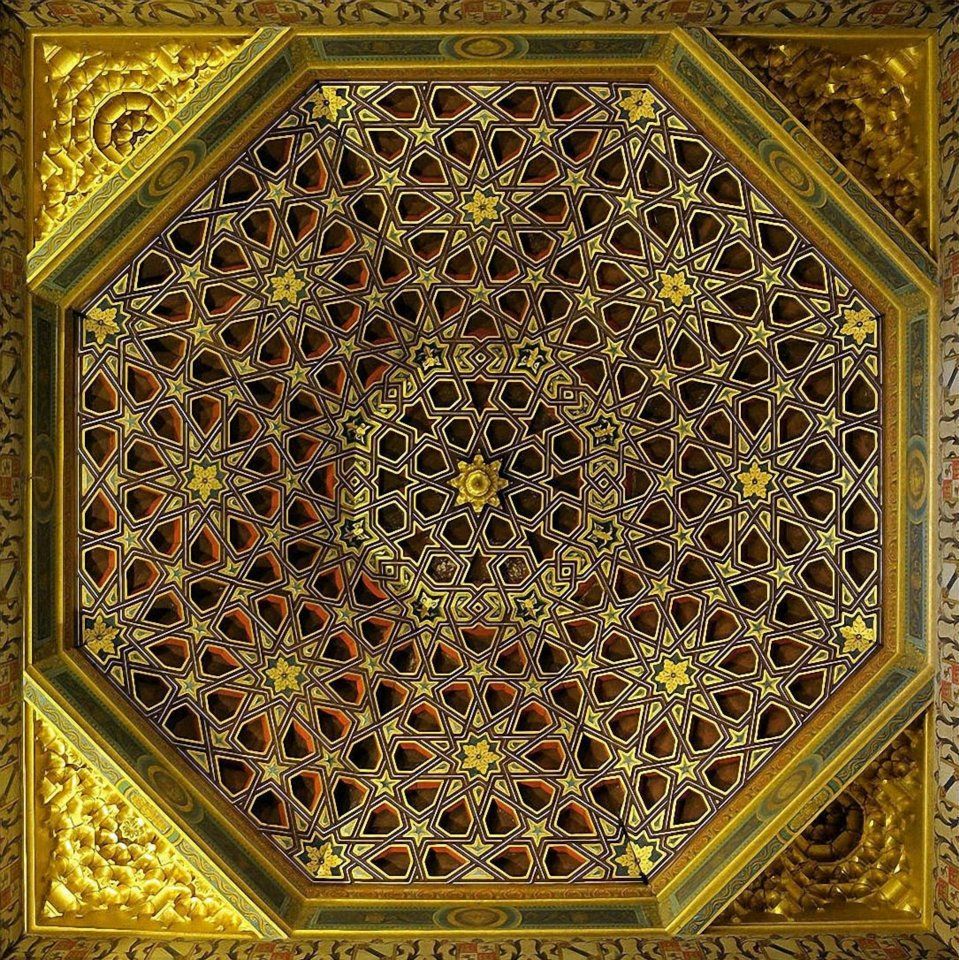
Later, decoration was dominated by repetitive rhythmic patterns often using less expensive materials, e.g. tilework, brickwork, wood carving, plaster carving, etc. Its influence in Spain survived well into the 17th C.
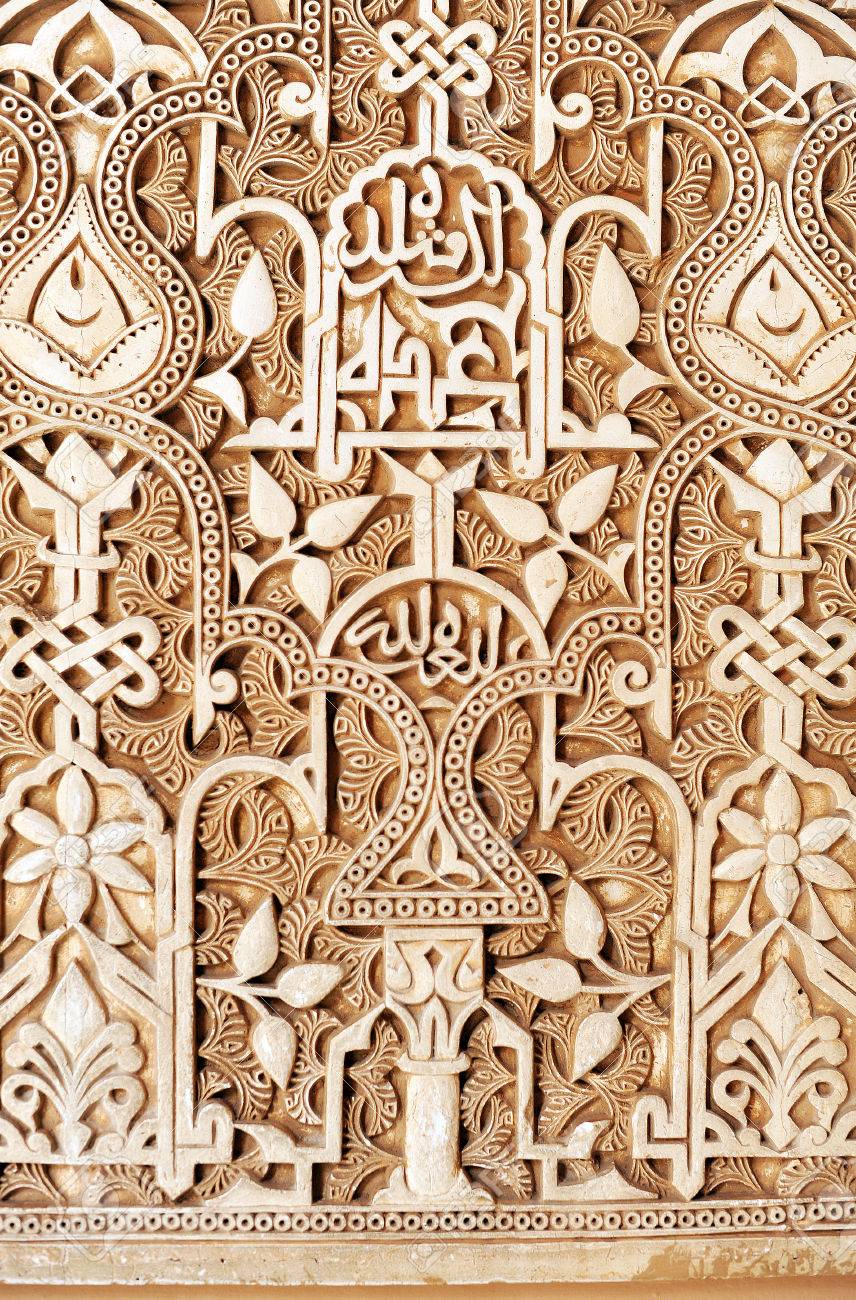
So initially the Mudéjar kept their protected religious status, but in the mid-16th C, they were forced to convert to Christianity. From that time they were known as Moriscos. In 1610 those who refused to convert to Christianity were expelled from Málaga. The layout of the Muslim city was changed in the 16th C to suit the needs of the Christian conquerors, beginning with the construction of a wide road to allow the transport of merchandise from the main square, the Plaza Mayor (now Plaza de la Constitución) to the Puerta del Mar gate, in present-day Calle Nueva. At this time also the transept, nave and main chapel of the Cathedral of Málaga were built on the foundations of the old mosque.
By the mid-16th century Málaga had been repopulated. It was dominated by a noble elite who had also benefited most from the redistribution of properties and land. Already by 1611 these nobles held most of the positions of power in the city, although the Crown remained in control through its royal officers. The local council collected rents and decided where the money should go, usually ⅓ salaries, ⅓ investment, and ⅓ repairs, etc. What you saw was a society divided into three economic sectors. Firstly, there were the farmers, ranchers, fishermen, etc. Secondly, there were those specialising in textiles, wood, metals, etc. Finally, there were the merchants, doctors, inn keepers, etc.
Trade, dominated by foreign merchants, was the main source of wealth in Málaga of the 16th C, with wine and raisins as the principal commodity exports. The artisanal productions of Málaga also included textiles, leather, clay, metal, wood, building construction and prepared food. The city became a shipping centre for export of the surplus agricultural output of the kingdoms of Córdoba, Jaén and Granada. The production of silk textiles was still important and closely linked to the Moorish part of the population. During the 17th C and early 18th C, the city entered a period of decline, a consequence not only of the social disruption caused by the expulsion of the Moors, but also due to flooding of the Guadalmedina River and several successive crop failures. Other disasters and disruptive events of the 17th C included earthquakes, explosions of gunpowder mills, and the almost constant involvement of Spain in different conflicts (conscription, taxes, etc.), but despite all that the population increased.

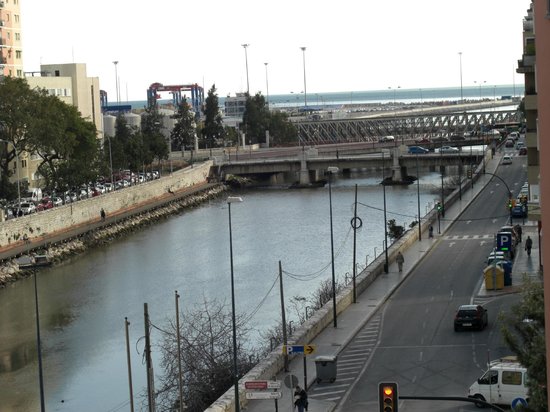
We can see how the Guadalmedina River can still today change radically from one day to another.
Let us go back and focus for a moment on the year 1594. Málaga had a population of around 13,000 people, and an urban nucleus crowded with foreigners and soldiers, and "most neighbours from strange nations such as English, French, German and others". The city was ramshackle and dirty, the walls had been battered, and the place smelled of manure, rottenness and garbage, mixed with wine, gunpowder, fresh bread, and incense and firewood. There were frequent procession and prayers involving rain for the harvests. This was the year in which Cervantes spent 20 to 25 days in Málaga. The city was a market, crowded with shops, stalls taverns and "casas de trato" (brothels). It is thought that Cervantes, who loved gambling, will have spend much time playing cards. He also mentioned that there were so-called "mujer enamorada" (women in live) who were free prostitutes who roamed the streets around the Port, looking for ships loaded with rich men, important merchants, and wealthy and tall foreigners. A few years after the visits of Cervantes both neighbours and foreigners had to leave their swords with bailiffs before visiting houses of "public women".
Shortly after the conquest, the Catholic Monarchs recognised the strategic military importance and commercial potential of Málaga. They looked to improve the water supply to the town, and develop the port (e.g. maintaining the old Muslim pier, the construction of an anchorage defended by breakwaters, the construction of a wharf, and the building of a port). But almost every effort failed due to flooding, storms, and incompetence of the authorities. Finally in 1717, after more than 200 years, Felipe V (French, 1683-1746) commissioned the French engineer Bartholome Thurus to redevelop the port, which would satisfy both commercial and defence needs of the population. This involved extending one dock, building a lantern as it was then called (lighthouse), constructing a commercial port, and improving the defences. Under Carlos III (Spanish, 1716-1788) there were numerous additional projects to increase the capacity of the port facilities, (e.g. dredging, the construction of the dam, the expansion of storage areas, and a new wharf). In 1783 the king approved the project to create the Alameda on land reclaimed from the sea.
Málaga, as headquarters of the Capitanía General de Granada (Captaincy General of the Kingdom of Granada), played an essential role in the foreign policy of the Bourbon kings of Spain. The regional military, the supply of the North African presidios (fortified bases), and the defence of the Mediterranean were administered in the city. This involved massive defence spending on fortification of the harbour, the building of coastal towers and the organising of militias. The loss of Gibraltar to the British in the Battle of Málaga of 1704 made the city the key to the military defence of the Strait.
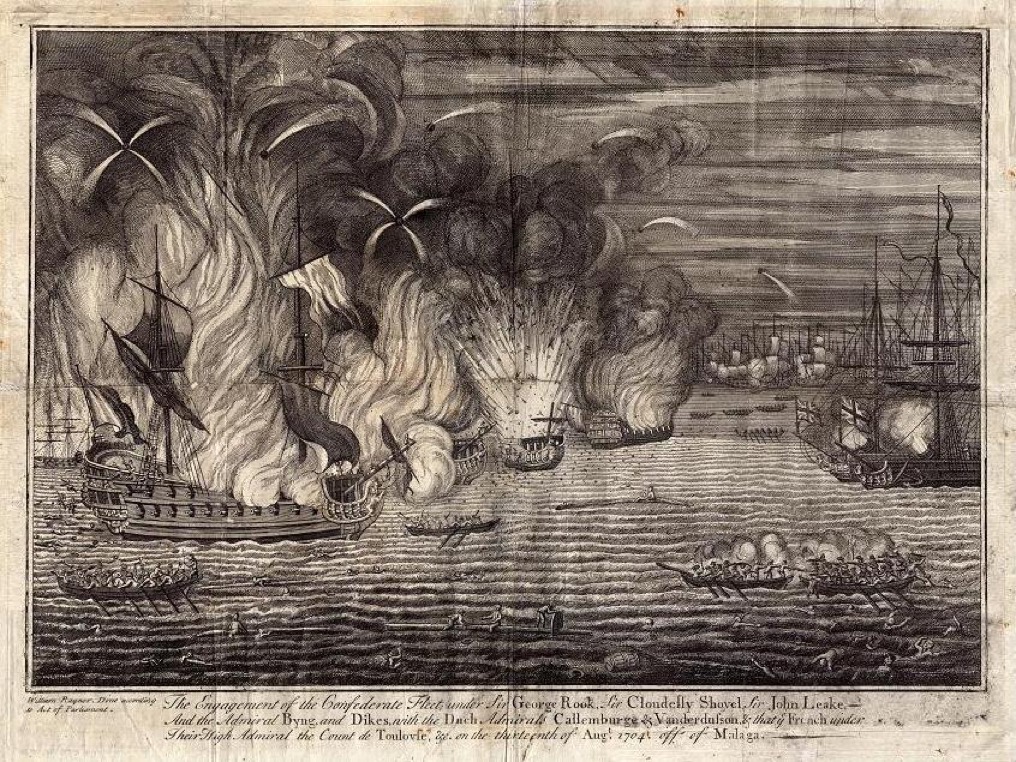
Gibraltar was captured in 1704 by an Anglo-Dutch fleet during the War of the Spanish Succession, and at the end of the war it was ceded to Britain under the Treaty of Utrecht of 1713. The Battle of Málaga took place in 1704 and was the largest naval battle in the War of the Spanish Succession. In fact less than a week after capturing Gibraltar there was a battle between the French and Anglo-Dutch fleets. The Anglo-Dutch fleet consisted of 3,614 guns and more than 22,000 men, and the French fleet 3,577 guns and 24,000 men. The outcome of the battle was indecisive, as no single vessel was sunk or captured. However numerous ships were damaged and there were casualties on both sides. There was no final engagement, and the French left thinking that they had gained a victory. But the reality was that the damage to the French fleet was such that they were never again able to emerge from their base in Toulon at full strength.
During the second half of the 18th C Málaga solved its chronic water supply problems with the completion of one of the largest infrastructure projects carried out in Spain at the time, the building of the Aqueduct of San Telmo, designed by the architect José Martín de Aldehuela (1729-1802). After the success of this impressive feat of engineering, the city enjoyed an economic recovery with a new expansion of the port and the revival of the works of the Cathedral of Málaga. The erection of the new Customs building, the Palacio de la Aduana, begun in 1791. The peasantry and the working classes still made up the vast majority of the population, but the emergence of a business-oriented middle-class lay the foundations for the 19th C economic boom.
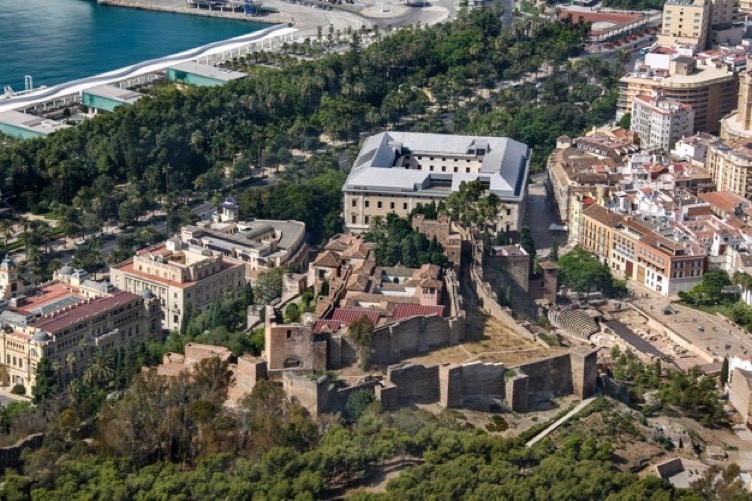
Here we can see the Palacio de la Aduana sat next to the citadel and the castle connected by La Coracha. It is a neoclassical building modelled on a Renaissance palace, and it was originally designed as a customs house. Later it served as part of a tobacco factory, the seat of the local government, a part of the Franco-lead regional government, a police station, and now finally it is home to the Museo de Málaga.

As compared to the above photograph you can see how the sea front has been radically altered when they reclaimed land for the Paseo de la Alameda.
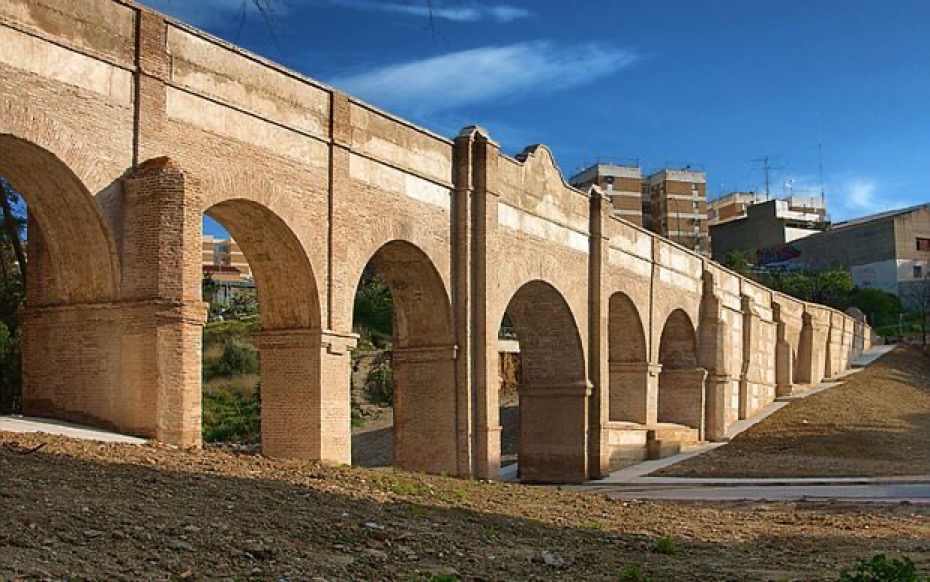
The San Telmo Aquaduct was in fact a very complex hydraulic project. The idea was simple, take water from the Guadalmedina River and bring it into the city.

Firstly that meant 11 km crossing steep hillsides, part rural (still in use), part urban (no longer used), 33 drains, two tunnels, cisterns, vents, and 30 bridges (one 75 m long and 15 m high). Secondly two superimposed canals one above the other, the lower one covered for portable water for fountains, washing places, etc. in the city, the upper one open for irrigation and the running of 12 water mills located on 6 “falls”.
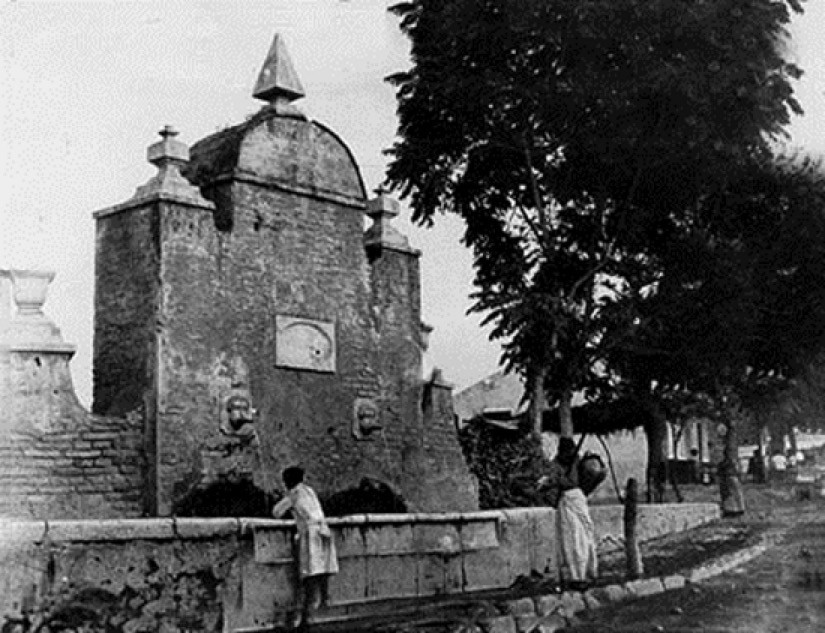
Thirdly, a brickwork dam was built with a sluice to control the flow along the canal. The work began in 1782 and was finished in 1789.
By the 18th C, the port of Málaga, the linchpin of the city’s economy, was again one of the most important on Andalusia’s Mediterranean coast. Following the Decree of Free Trade (one of the Bourbon Reforms) in 1778 by King Charles III, which allowed the Spanish American ports to trade directly with ports in Spain, commercial traffic at the port increased further, and the population grew considerably. Major urban renovations were made in Málaga under the influence of the ideas of the European Enlightenment, bestowing on it many of its most characteristic features, e.g. the Cathedral, the harbour of the port and its Customs House, and the major roads to Antequera and Velez-Málaga. In 1783 a bay front boulevard, the Paseo de la Alameda, a symbol of urban prosperity, was built on land reclaimed from the sea with sand dredged from the Guadalmedina River. By 1792 mansions had risen on either side of the avenue in the fashionable new residential area settled by the Málaga merchant class.
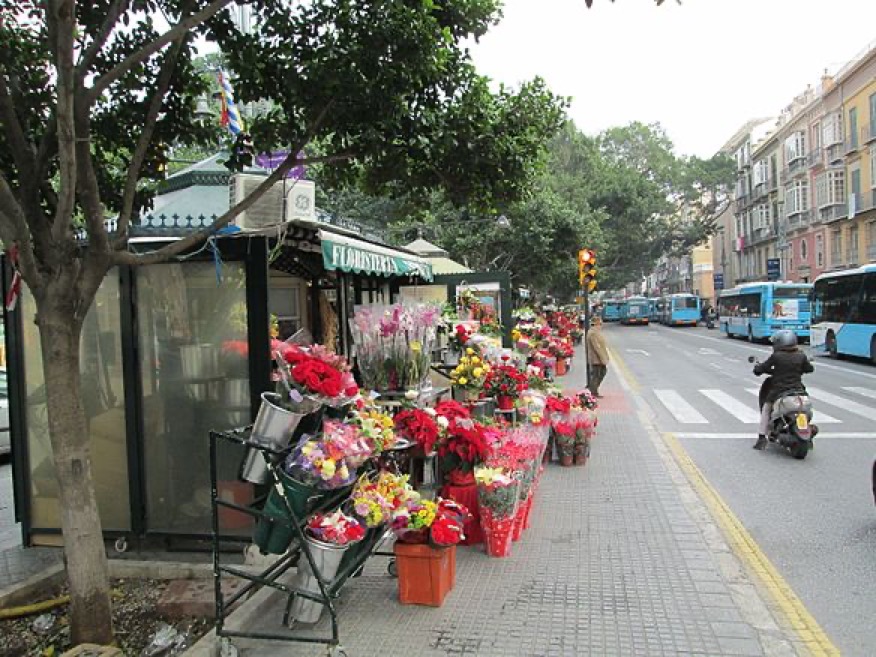
The Paseo de la Alameda is still one of the most important features of city. Remodelled in the 19th C it runs from Avenida de Andalucía which crosses the Guadalmedina River over the Puente de Tetuán, and runs past Calle Marqués de Larios to Plaza de la Marina. It is a key place for bus stops in the city, and there are numerous flower kiosks in the central isle. At the moment (2015-2016) it was a bit of a mess, due to the building of the new city tram system. If you search for Paseo de la Alameda on the Web (which today is called Alameda Principal) you are often shown Paseo Parque (below) which runs through the Parque del Paseo de Los Curas. So they often show you the wonderful promenade through the gardens and not the actual road with the busses and new tram.
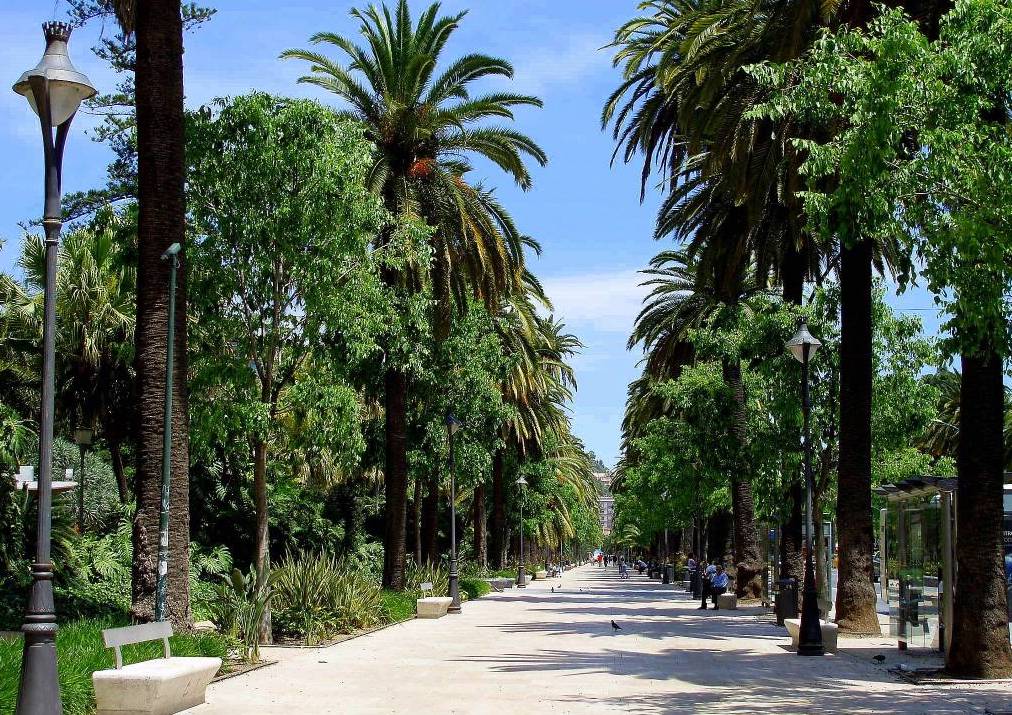
The Parque del Paseo de Los Curasis also called Parque de la Alameda, Parque de Málaga, or simply el Parque, and was actually built nearly 100 years later, in the late 19th C (and the planting of the parks actually only dates from 1899).
The 19th century was a turbulent time of political, economic and social crisis in Málaga. The War of the Third Coalition (1803–1806) fought against Great Britain, decimated Spain's maritime commerce. And the deadly 1803–1804 epidemic of Yellow Fever killed more than 26,000 people in Málaga alone. The city suffered the further ravages of the Peninsular War (1807-1814), conflicts between royal absolutists and liberals, the end of the transatlantic trade with the Americas, the collapse of its industries, and finally the phylloxera epidemic that destroyed the vineyards of the region.
The first references to Málaga wines can be traced back to the Phoenicians, as with most of the wine making regions in Spain. The Romans were the ones that really started to produce wine in the region and planted most of the vines, and fermentation deposits have been found in Cártama, 30km away from Málaga. During the Muslim occupation in Málaga, taxes had to be paid to be able to produce wine, as it was prohibited by the Muslim laws, but after the Reconquista the wine makers of the area formed the Wine Makers Fraternity to promote their sector.
Málaga wines became quite famous in the 18th C. In 1791 the Spanish Ambassador in Moscow promised Catherine The Great, Empress of Russia, some cases of Málaga wine. She was so happy and so awed by their taste and quality that she banned any taxes to be placed on Málaga wines arriving in Russia. The phylloxera reached Málaga in 1878 and with the bug came the downfall of these excellent wines, which wouldn't recover until well into the 20th C.
Málaga wines were also commonly used for religious ceremonies, but they were mostly ignored until the arrival of people like Telmo Rodríguez. As an example, on his website we can see how rugged the local terrain is, and the unusual aspect of Pedro Ximénez vines used to obtain the original sweetness of Málaga wines. Currently, there's quite a demand for sweet wines (or dessert wines, as they're sometimes referred to) in which DO Málaga wines have found their place - quite a feat for a designation of origin with only 18 inscribed cellars. Below we can see the different classifications used in Andalucia, i.e. DO means "Denominación de Origen" (the main quality control system for Spanish wines), and IGP means "Indicación Geográfica Protegida" (sits below DO and indicates that a wine comes from a particular place). Both are part of the Spanish DOP "Denominación de Origen Protegida" system.
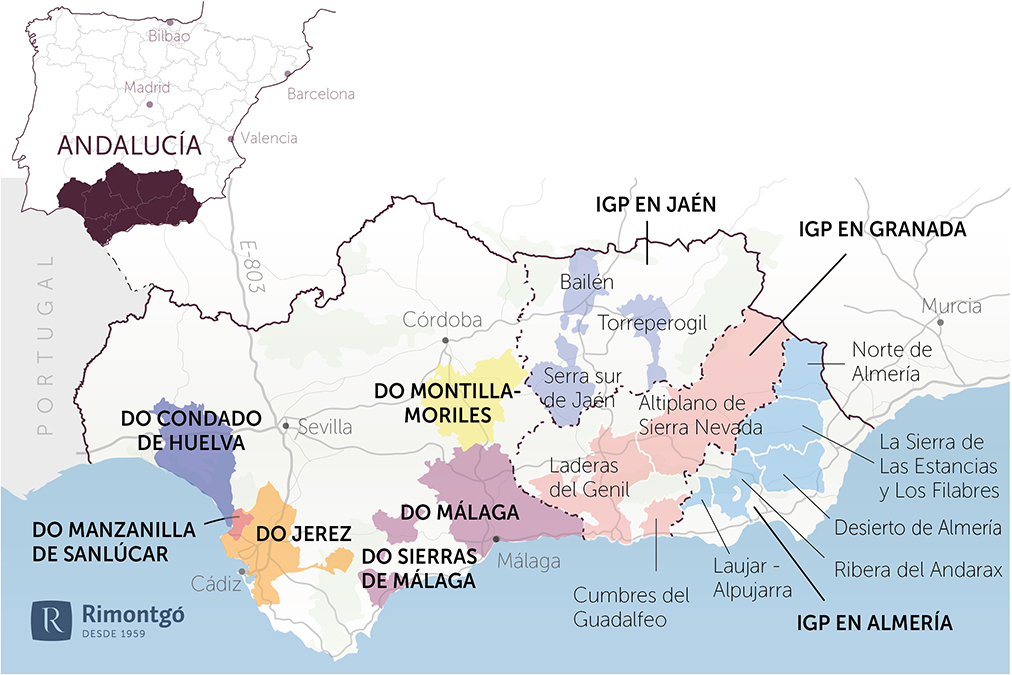
The DO Málaga - Sierra de Málaga was established at the same time as the DO Jerez, in 1933, during Spain's II Republic. The production takes place in five different areas of Málaga: Axarquía, Montes (mountains), Norte (e.g. Antequera), Costa Occidental (Málaga to Marbella) and the Serranía de Ronda, and each areas has its own characteristics. This generates slightly different wines, which enrich the designation of origin. My understanding is that the sweet Málaga wine production is centred on the Málaga and Norte regions. The areas of Axarquía and Manilva focus on Pasas de Málaga, an excellent table grape. The Serranía de Ronda makes more traditional white and red wines. You can always checkout the Museo del Vino, for more up-to-date information.
Bear with me, but Napoleon Bonaparte was known to drink daily a half a bottle of Gevrey-Chambertin (Grand Cru, 5-6 years old, from the négociant Soupé & Pirreugues) at both lunch and dinner (usually diluted with water). After the defeat at Waterloo (18 June 1815) Prussian forces seized Napoleon’s war carriage (a combination of dressing room, office and bedroom, all in mahogany). In the war carriage they found a bottle of “extremely fine old Málaga wine” bearing the Napoleonic cipher “N” bordered by laurel wreaths. It was auctioned recently for £25,000. I cannot conclude our little trip into the drinking habits of Napoleon without mentioning that he also loved Champagne (normally from Jacquesson Fils and always “sabre”), and once observed that “in victory you deserve Champagne, in defeat you need it”. In exile on Saint Helena he switched to drinking “Vin de Constance” (a South African dessert wine), and managed to down 100 litres a year. When we mention Napoleon, we must also mention Joséphine. She liked a dry, white Chenin Blanc “Coulée de Serrant” from her estate in Savennières. It is said that she had a cellar of 13,000 bottle, preferred Médoc to Claret, and collected wines from the Rhône, Languedoc, Cyress, Greece, Hungary and even South Africa.
On 2 May 1808 the people of Madrid rebelled against the French occupation of their city. This was followed by the abdication of the royal family in Bayonne and the proclamation of Napoleon's brother Joseph as king of Spain. When news of the uprising reached Málaga, its citizens revolted against the French invaders, with the guerrillas in the mountains putting up the fiercest resistance.
The Military Governor of Málaga province, General Theodor von Reding, held command of the First Division of the Spanish Army of Andalusia and was the architect of the Spanish victory in the Battle of Bailén (1808) during the Peninsular War. The French encountered strong resistance in Málaga and left much of the city in ruins when they withdrew. The war and revolts against Napoleon's occupation led to the adoption of the Spanish Constitution of 1812, later a cornerstone of European liberalism, by the Cortes of Cádiz. Málaga elected both representatives to send to the national legislative assembly and a new constitutional Town Council, which immediately implemented reconstruction plans. The French were decisively defeated at the Battle of Vitoria in 1813, and the following year, Ferdinand VII was restored as King of Spain. The burden of war had destroyed the social and economic fabric of Spain and ushered in an era of social turbulence, political instability and economic stagnation.
Although the juntas, which forced the French to leave Spain, had sworn by the liberal Constitution of 1812, Ferdinand openly held that it was too liberal for the country. On his return to Spain on April 16, 1814, he refused to swear by the constitution himself, and continued to rule in the authoritarian fashion of his forebears. Thus the first bourgeois revolution ended in 1814. The reign of Ferdinand VII from 1814 to 1820 was defined by a stagnant economy and political instability. Much of the country was devastated after the Peninsular War, and government coffers had also been drained to fight against the independence movements in the Latin American colonies. Political conflict between liberals and royal absolutists further depleted the resources needed to rebuild the country.
Many historians now talk of Spain in 1808 as stumbling through its first bourgeois revolution. We start with the threat of a French invasion, a hopelessly ineffectual domestic leadership, and a nation in bankruptcy. This led to the Cádiz Constitution of 1812, which was probably too extreme for most of Spanish society. The political Liberals could not retain power either in 1812-1814, or 1820-1823. The death of the unpopular Ferdinand VII left a succession crisis. Only now did the Liberal vs. absolutist argument move to one about the form of government people wanted. Spain was a traditional (backward) agrarian society dominated by a small oligarchy of aristocrats, landowners and wealthy Catalan industrialists (e.g. the Conservative party). By 1880 both the Conservative and Liberals drew their support from these same groups.
The economy of Málaga was driven by local trade in food, animal fodder, livestock, building materials, and fuel, plus commodities for export. Trading with other regions in Spain was just too difficult due to the lack of good roads, etc. Peasants worked across a combination of small plots, and paid royal taxes, Church taxes, tithes, rents and feudal duties. Self-sufficiency was not possible, so most had to also become day labourers, seasonal migrants, craftsmen, transporters, woodcutters, etc. which monetarised peasant life and exposed them to market forces. Landowners had to commercialise their good, and were exposed to market forces. Rising food prices meant they raised rents, taking aways any incentive of peasants to invest or save. So Spain was an agricultural country (e.g. rural and isolated) run as a society of classes and pressure groups (e.g. families, political groups, business networks, commercial interdependences). We cannot stress enough that life was tough in Spain, the average life expectancy in the 18th C was less than 27 years, and in 1900 it was only 35 years. The period 1770-1814 was a period of economic stagnation, crisis and decline. Economists tell us that during that period Spain was the worst in Europe for landless transients, rural land hunger, and urban misery, aggravated by capricious fiscal policies of the Crown. The period 1814 to 1840 was characterised by the loss of the American empire, resulting in a drop in Spain trade by up to 75%, and the Carlist Wars. Things only started to pick up again during the period 1840 to 1910, but characterised by often misguided modernisation, squandering of resources, agrarian crises, and protectionism.
There were several attempts to install a liberal regime during the absolutist reign (1814–1820). In 1820, an expedition intended for the American colonies revolted in Cádiz. When armies throughout Spain pronounced themselves in sympathy with the revolters led by Rafael del Riego, Ferdinand was forced to relent. On 9 March 1820 he finally accepted the liberal Constitution of 1812, and appointed new ministers of state, thus ushering in the so-called Liberal Triennium (Trienio Liberal), a period of three years of liberal government and popular rule in Spain. This was the start of the second bourgeois revolution in Spain, which would last from 1820 to 1823. Once again in the revolution of 1820, it was the independent towns such as Málaga that led the drive for constitutional change in Spain. Ferdinand himself was placed under effective house arrest for the duration of the liberal experiment.
The tumultuous three years of liberal rule that followed were marked by various absolutist conspiracies. The liberal government was looked on with hostility by the Congress of Verona in 1822, and France was authorised to intervene. A French army under the command of Duke of Angoulême, invaded Spain in the so-called Spanish expedition and overwhelmed the armies of the liberal government with massive force. Ferdinand was restored as absolute monarch in 1823, marking the end of the second Spanish bourgeois revolution.
During the "Ominous Decade" (1823-1833), the name given to this period of return to the reactionary power of absolutism, the liberals suffered under a wave of repression and acts of vengeance. In 1831, the liberal general José María Torrijos y Uriarte (1791-1831), who fought against the absolutist regime of Ferdinand VII and for the restoration of the Constitution of 1812, set his field of operations in Málaga province. He and his men were captured in Alhaurín de la Torre after their betrayal by the governor of the city. They were executed by firing squad on the beach of San Andrés (now a residential and tourist area south of Málaga). Torrijos' remains are buried under the obelisk erected in his honour at the Plaza de la Merced in the centre of Málaga.
As Málaga pioneered the Industrial Revolution in Spain, its educated and entrepreneurial merchant class agitated for modernity in government, making Málaga one of the most rebellious cities of the country. The bourgeoisie led several uprisings in favour of a more liberal regime to encourage free commercial enterprise. In late 1833, soon after the death of Ferdinand VII, a revolt was organised against the inefficiency of the government of the Count of Toreno (Conde de Toreno), who had been appointed prime minister by the queen regent, Maria Christina. His tenure in the premiership lasted only 3 months. 1833 was the start of the so-called Carlist Wars (1833-1840, 1846-1849, 1872-1876, 1936-1939), a battle between Catholicism and the Bourbon dynasty, and liberalism, and later republicanism. In 1835 Málaga saw riots due to the supposed lenient treatment of Carlist's in prison. The clash between the heavy-handed military governor and the more conciliatory civil governor quickly spiralled out of control. Málaga, one of the most liberal cities in Spain, had become radicalised by a civil war. A crackdown on secret societies was ordered, double regimes appeared in local councils, revolutionary symbols replaced Royalist flags, police files on protestors were burnt, convents and monasteries were destroyed and clerics killed.
I do not intend to provide a detailed history of the Carlist Wars (or in fact of the history of Spain). My first objective here is to simply underline that Málaga was a liberal and progressive city, but as with many port-cities in Spain, could easily become radicalised. My second object is to note that Málaga has played an important and persistent role in the history of Spain. But despite all that, throughout the first Carlist War, Málaga was the only Spanish sea-port to continued to register a positive trade balance with the outside world (despite rampant smuggling for which the city was also renowned).
The Ecclesiastical Confiscations of Mendizábal in 1836 resulted in a new initiative to modernise the city. Religious convents had accumulated property since the Reconquista, and by the end of the 18th C a fourth of the urban properties bounded by the ancient city walls belonged to religious orders or similar fraternal organisations. With the seizure of the church holdings, many of these buildings were demolished and new buildings or streets or squares were built to replace them. The site of the convent of San Pedro de Alcantara became the Plaza del Teatro, while the convent of San Francisco was replaced by an architecturally refined square which became the home of the Lyceum and the Philharmonic Society.
In what I've written so far, and what will follow, there is an air of explaining the past with a slightly romantic, or at least benevolent, perspective. So just to throw in an alternative, let's turn for the moment to the impression of a traveller arriving in Málaga in 1838.
"The appearance of Malaga on a near approach is mean and unprepossessing, nor is this an optical deception, for the suburbs are miserably poor and excessively dirty. This last, indeed, is a fault that the city may change. But such is the contempt in which the virtue of cleanliness is held by the inhabitants, that the little river Guadalmedina, which winds its way through the heart of the city, if properly husbanded could keep the place sweet and clean. Yet, from mismanagement, it itself suffers to become a nuisance. The scanty stream left after supplying the fountains in summer, is so obstructed by heaps of filth, brought out from the city, and thrown into its wide bed, that it does not have sufficient power to carry off the accumulated mass of corruption, and serves only (by keeping' it constantly moist) to render the process of putrefaction more fetid and deadly.
The calm indifference with which the inhabitants of Malaga endure the intolerable nuisance thus generated by their improvidence and indolence, and the patience with which they look forward to the winter torrents to rid them of it, contrast singularly enough with the immoderate alarm occasioned by the arrival of a vessel from the Habana, and the haste with which they send it from their port to undergo purification at Minorca. Thus, whilst dreading most unwarrantably the importation of the yellow fever from a place which, at the time, perhaps, was perfectly free from it, they disregard altogether the little forcing-bed of miasmatic diseases, situated under their own immediate noses."
Our traveller does mention the Alameda as "a fine open space", the handsome Cathedral, accepts that the inns are tolerably good, but he did also note the ruinous condition of the Alcazaba. He knew that once the city was known for its silk, linen and hats, but now focussed on preparing wines and dried fruits for the foreign markets. He understood that upwards of 18,000 butts of wine, both sweet and dry, were shilled annually from Malaga, mostly to the Americans. But that Malaga Sherry did also find its ways to English cellars, where is was sold at a profit as "old Brown" or "old dry Sherry". Malaga continued to export cured fish, but the expert of olive oil was dominant even if, he thought, almonds, oranges and raisins fetch the best prices.
He was very positive about the conversion fo the custom-house to a Royal cigar manufactory. He was so impressed he described in detail the workings of the factory. It employed 700 people, most women and children, in making cigars. A good pair of women's hands could produce 300 cigars a day, meaning a total production of 140,000 cigars daily. He added that to the production of the factory in Seville, and concluded that around 700,000 cigars a day were far below what Spain was likely to consume. He felt that this inability to meet demand encouraged smuggling and smoking papelitos (cigars made with chopped tobacco rolled up in paper).
He also note that people were paid one reales vellon for rolling fifty of the best Habana leaf cigars, and they were sold for 30 reales vellon for 100 cigars. Give that the very best cigars from Habana cost only ⅔ of that, he felt smuggling was inevitable.
The second half of the 19th century began a period of prosperity in Málaga, with an economy energised by the resumption of traditional mercantile activities and new industrial employment. This positioned the city as an important European manufacturing centre, based upon steel, chemistry, and cotton textiles. Manuel Agustín Heredia's ironworks, La Constancia, located in San Andrés, started a run of productivity in 1834 that made it the country's leading iron foundry.
In the mid-19th century Malaga's port warehouses were full of Muscat grapes, figs, wines, almonds, bitter oranges, etc. ready for expert (bit like a big Christmas cake). Fried anchovies were being vacuum packed, boats were still being built in the shipyards, tanning, beer, sugar, salting, lemon essence, soap, paint, pottery, tiles, etc., also had their large factories.
Manuel Agustín Heredia (1786-1846) was originally an exporter of olive oil, dried fruit and wine, charcoal, and also an investor in the Banco de Málaga. He moved into mining and iron production in 1826, initially with iron mining and cast iron (pig iron) production in “La Concepción” in Marbella.
HIGH HORNOS / FERRERÍAS
The main wealth of Marbella at that time, around the nineteenth century, was the foundry of metals in its ironworks (Ferrería del Angel y La Concepción), approving the vicinity of the mines of Ojén (which were 'magnetite'), en especially the mines La Choza, San Juan Bautista and San Nicolás, the mineral mineral used in the ironworks through a cable from the mines of Peñoncillo. You can see the fall of the Peñoncillo mines on this route of trekking between Marbella and Ojén.
Descargadero-mineral
In April 1869, a request was made to the Marbella City Council, for the cesion of land to set up the railroad track and part of it explained next to the metallic dock that had been planned to be built from Sierra Blanca. This railroad was known as Ferrocarril Minero de San Juan Bautista. I am dedicated to accessing many products made by the Angel factory.
The company explored the set of mines in Peñoncillo, starting in 1891 to export 96,529 tons of mineral. Through a line of 6 km and metric anchor, with steam traction, the project was drawn up in 1869, in an itinerary that departed from the Arroyo del Peñoncillo in Ojen, receiving mineral from the mines of San Juan Bautista and La Concepción. Opening its itinerary in Marbella, next to the Estepona wagon, from where an apartment and a mineral deposit were established, with a weighbridge, to form trains up to the ship. These land and land lines in their entirety were public land donated by the Ayuntamiento de Marbella.
interior-company-mining-marbella
Muelle-de-hierro-2
For this work, several locomotives were used:
locomotives-mine-marbella
The most powerful locomotives (Dick & Stevenson) with 40 CV were the most resistant and well known. Hay sospechas que locomotoras nº 4 y 5 fuesen mismas, but with a different name. You only developed 5.68 CV.
CARGUERO / TRANSPORT TOWERS
The Transport Towers were the last of the architectural elements to disappear, but everything else was dismantled bit by bit. One of the towers still follows the pie, specifically the last of the process: the tower of the carguero.
The current play 'El cable' by Marbella has this name in honor of the tower that remains built in the waters of the municipality. (If you are interested in seeing it, you can visit it in these coordinates)
muelle-carguero-hierro-mina-marbella
«This work of ingenuity built in 1957 by Dragados y Construcciones, known as the maritime cargo ship in Marbella and the one that only falls at the Poste del Cable, was not the final part of the entire funicular airway system, which through it of turrets and a monocable, he betrayed the mineral from the mine of Peñoncillo hierro passing over the N-340 it has medium tonnage boats (which could not enter the fishing port, from there the construction of this work) that cargaban en su bodega. There is not much time left for the last of these turrets, which, like the Tower of Pisa, was flanked on the sandy bottom of the cable beach. » (Extracted from: MarbellaActiva.es)
PHOTO GALLERY
On this occasion we will speak about the steel industry, specifically about the “La Concepción” and “La Constancia”, one of the most modern ironworks for its time in the world, which counted on a large number of machinery like 22 pudler , 5 loud horns, 22 steam engines and 18 boilers.
The operation of this type of industry was conditioned by several factors, the supply of fuel, since there was to be a large corner of land surrounded by the factory, as well as having a high calorific value. The leña, the vegetable carbon and, finally, the constituted mineral carbon, in addition to a high-grade mineral, the basic resource for the construction of the glued hierarchy necessary for high-precision machinery. They also needed technological know-how, financing and mineral deposits.
In Malaga, there were 1826 this series of factors, the technological know-how of the exceptional ingenious logroñés Francisco Antonio de Elorza, the financial and business instinct of Manuel Agustín Heredia and the mineral deposit of Ojén.
But I encountered a problem, as in all Andalusian steel, energy. Heredia's first metallurgical installation was located in Marbella, next to the Verde River, which provided strength to the hydraulic wheels of the “La Concepción” ironwork when the first glued in 1831. The technical difficulties inclined Heredia to build a second iron in the Malaga playa de San Andrés with the purpose of receiving all the importations of the necessary carbon for the good functioning of the affinities installed there. I received the name of “Constancia y Trabajo”, an emblematic name that summarizes the ideals of this entrepreneur, and between 1834 and 1839 he worked with the factories at full profit. Casi al mismo tiempo, Juan Giró, another Malagasy industrialist, I set off on the march of other factories: in Marbella los alto hornos and in Malaga the “El Angel” pudding factory (1841).
The playa de San Andrés, with the running of time, became an area of important metallurgical and chemical aspects, among which we highlight the Constancia, the Industria Malagueña SA, La Vers SA, Fundición Ruperto Heaton, Los Guindos Sociedad Minero -Metallurgical, Dichromate Potásico and Unión Española de Explosivos.
From the tall horns of “La Concepción”, only the remains of three of the four tall horns and the cuffs, the abbreviation, and a hood that keeps the image of the Virgin of the Conception and some dependencies converted into the residence are preserved. .
The hardware of the Conception is one of the most relevant enclaves of the industrial history of Spain. The demise of the success of being included in the National Industrial Heritage Plan.
TECHNICAL INFORMATION
According to Madoz, in 1847, the factory included the following:
- 3 charcoal blast furnaces
- 1 roasting furnace
- 2 common forges
- 4 stoves and equipment to heat the air using the furnaces
- 3 double-action wind machines equipped with hydraulic wheels
- 1 high-pressure steam engine
CURRENT CONDITION
The blast furnace ruins are located within a private property dedicated to restaurant and events services.
ADDITIONAL INFORMATION
By 1837, Marbella's foundry had two blast furnaces—13.20 m high, 2.40 m in diameter— plus a spare one—11.40 m high, 3 m in diameter— that received the air from two hydraulic machines. There were 30 operators responsible for the furnaces and machines at the time. The ore came from the Peñón and the Peñoncillo, two nearby mines that were worked in the open air.
http://patinaindustrial.blogspot.com
and then with the blast furnaces “La Constancia” on the San Andrés beach (for wrought iron). It was one of the most modern foundries in the world, and the first blast furnace in Spain. It used English coal which was taxed at 50% by Madrid. The foundry consisted of five blast furnaces, 22 puddlers, 18 boilers, and 22 steam engines. By 1841 they were employing 2,500 people. In 1846 he joined with the Larios family to create “Industria Malagueña” for the production of yarn and textiles in wool, linen, and hemp. The mills were built next to “La Constancia”, and by the 1860’s they were employing 1,500 people. These two activities created an industrial area between the Rio Guadalmedina and the beaches of San Andrés. This attracted “la Fábrica de Gas” for street lighting, “Lapeira Metagraf” for making tin cans decorated with lithographs (often used for olive oil), Taillefer for industrial vehicles, flour mills Castel, the tobacco factory (now a museum), and many other smaller companies for paints, wine, food and railways. Energy was always the problem. Coal was imported and expensive, and national alternatives turned out to be just as expensive. WW I saved the furnaces, but then Málaga saw a decline in iron and textiles, in favour of cane sugar production (unfortunately in a very volatile market). Fortunately agriculture, and in particular raisins and wine, came to their rescue, until the arrival of phylloxera in 1878. This story of the industrial revolution of Málaga, is in many way symbolic of the industrial revolution throughout Spain.
Despite considerable political instability in Spain, Málaga with its progressive town councils went from strength to strength. The expanding economy in all sectors required an increased money supply and capitalisation apart from that offered by the professional moneylenders. In 1859, Jorge Loring founded the private Bank of Málaga, the first to issue currency under the national Act of 1856. The bank's business was based in the booming steel and textile industries, and in trade through the port. In 1862, Queen Isabella II and her consort Francisco de Asís María Fernando de de Borbón visited Málaga to mark the official opening of the Córdoba-Málaga railway (now part of the Alta Velocidad Española), and the Málaga railway station. Through all this Málaga remained a liberal and progressive city, with a republican bias. When Isabella was driven into exile in Paris, euphoria reigned in Málaga when General Prim and the other revolutionary generals landed at the port.
As an example of the constant willingness of the people of Málaga, not just to accept change, but to provoke it! In 1873 pro-Republicans took to the streets of Málaga, erecting barricades supporting the Cantonal Revolution, a Cantonalist uprising whose goals included the redistribution of wealth and improvement of the situation of the working classes. There were major disturbances in the city during the insurrection (el Cantón de Málaga) led by local militia leader Eduardo Carvajal, and at the same time civil governor Francisco Sorlier established the Cantón Federal Malagueño Independiente. The Customs House was assaulted and its files and dossiers burnt. The story goes that factional clashes continued until General Pavía entered the city with his troops and ended the Cantón de Málaga on 19 September 1873. However the story is just a little bit more complicated. Pavia had already “pacified” Cádiz and disarmed Granada, but he resigned when told not to attack el Cantón de Málaga (it was not accepted). The civil governor Francisco Sorlier was dismissed and a small garrison commander was ordered into Málaga. Pavia resigned again saying that he alone should enter Málaga, but at the same time he took Écija and punished the local population as an example. Pavia resigned twice more, but at the same time met with Francisco Sorlier, and accepted that he and his men could leave Málaga. Pavia arrested and disarmed them in Bobadilla, bringing to an end one of the longest running cantonal revolutions.
There were social changes as well as economic ones in Málaga during the reign of Queen Isabella II. The bourgeoisie solidified its position as an oligarchy in control of local politics, while a labouring class of industrial workers developed in the factories. The presence of these large factories resulted in the growth of an industrial and workers' suburb on the banks of the Guadalmedina river, separate from the residential areas of the bourgeoisie in the centre and the eastern part of the city. The city's population continued to grow, creating a need for the expansion of civil infrastructure.
The monasteries were not only religious centres but also places where Málaga's cultural heritage was preserved and even, occasionally, where political power was exercised. Their spatial distribution affected the development of the city outside the medieval centre. On the western edge the urban landscape began to take shape under the influence of industrial activity, while at the eastern end of the city villas and hotels began to appear. With the seizure and subsequent demolition of old church buildings, the city gained new opportunities for growth.
Today we can still see the difference between the west (popular) and east (bourgeois) Málaga.
Communications were improved in the province with the construction of new railway lines to transport raw supplies and industrial products. Jorge Loring y Oyarzábal (1822-1901) and Joaquin de la Gandara y Navarro acquired numerous small rail lines and unified their interests in 1877 to create the Andalusian Railway Company (Compañía de los Ferrocarriles Andaluces), which owned most of the tracks in Andalusia. This consolidation and expansion helped create a common regional market for trade goods.
Málaga benefitted from substantial economic development in the first half of the 19th C, and by 1850 it ranked second in industrial production among the provinces of Spain, after Barcelona. The textile and steel industries generated a number of ancillary industries, including factories for soap, paint, and salted fish, along with local breweries, timber mills, potteries, brickworks, and tanneries. Their production necessitated the building of a rail network between Córdoba and Málaga, which was connected with the national network on 15 August 1865. The city acquired public gas lighting on 6 July 1852, the Gas Lebón Company supplying the city with gas until 1897, when electrification was introduced. A public tram service with horse-drawn carriages began on 19 November 1881, and in January 1901, electric power replaced the horses.
In 1880 the city council formed a corporation to promote the construction of the Calle Marqués de Larios, in honour of the textile industrialist and financier Manuel Domingo Larios (1836-1895). The project was capitalised to one million pesetas by selling shares distributed in lots of forty shares of 25,000 pesetas each, most of them acquired by the Larios family. The plans were drawn and the works directed by architect Eduardo Strachan Viana-Cárdenas (1856-1899). The grand street opened in 1890. This was the beginning of the modernisation of the city envisioned by Theodor von Reding (1755-1809) and executed by the architects Manuel Rivera Vera (1879-1940), Jerónimo Cuervo González (1838-1898) and Fernando Guerrero Strachan (1879-1930).
The rise of dissident workers' organisations and the increase of labour conflicts with the local oligarchy reflected social tensions at the end of the century. The origins of the socialist unions in Málaga date to a workers' athenaeum founded in 1884 by Rafael Salinas Sánchez (1850-1919), known popularly as the "apostle" of socialism. Sánchez was born into a working-class family in the El Perchel barrio. His childhood family life was marked by the typical hardships of the working classes of the 19th C. As a young man he became an active member of the workers' unions, notably the International Association of Workers, and was forced into exile in 1874 for two years in Cuba during the Restoration. In 1884 he founded, with Antonio Valenzuela, the Agrupación Socialista de Málaga. That the socialist cause was taking hold in the provincial capital was evidenced by the more than 2,000 attendees at a rally in 1890 at the Café El Turco (one of the coffee shops in the Plaza de la Constitución).
While running as a candidate for Parliament in 1891, Salinas organised local chapters in eastern Andalusia of the Unión General de Trabajadores (UGT), or General Union of Workers, which held its Third National Congress in Málaga in 1892. They produced plans to assuage the working conditions of workers in the Larios' textile factory, but Salinas was jailed for his support of the workers and harassed by the authorities. The Partido Socialista Obrero Español (PSOE), or Spanish Socialist Workers' Party, and the UGT were repressed throughout the province in the following years, which saw frequent clashes between workers and employers.
This painting Y tenia corazón! (Anatomia del corazón) was painted by Enrique Simonet y Lombardo (1863-1927), a painter of the Social Realism movement in Málaga.
The end of the economic boom in 19th C Málaga started in 1880 when the high cost of importing coal for steel production made its foundries less competitive with those of the industrial complexes in northern Spain. The economic crisis of 1893 finally forced the closing of the La Constancia iron foundry, which was accompanied by the collapse of the sugar industry and the spread of the phylloxera blight, which devastated the vineyards of the province. The abandonment of farms and consequent neglect of the terraces where the vines were cultivated resulted in gradual deforestation of the slopes, causing increased flooding after heavy rains, with severe erosion in the beds of the streams and rivers of virtually the entire coastal area. The more vulnerable sections of society were hardest hit by the repercussions of the economic crisis, especially farm labourers and small landholders in the rural areas, along with industrial workers and artisans in the urban areas. Tens of thousands of Malagueños emigrated overseas in search of better opportunities.
More than 150,000 left Andalusia in the last 20 years of the 19th C. Most went to the Americas, Brazil on the coffee plantations, Hawai’i for the sugar industry, Puerto Rico, Dominican Republic, Cuba, Guatemala, Costa Rica, Panama, Colombia, Venezuela, Argentina, Chile, Peru and Ecuador. Andalusians also colonised the Canary Islands, created communities in North Africa, and even travelled as far as the Philippines. Recently migration from Andalusia is still a reality, between 1951 to 1975 nearly 25% of the population of Andalusia moved to other areas of Spain, and in 1962 to 1974, more than 700,000 Andalusians moved to France, Germany, the UK, Belgium and the Netherlands. In the early 70’s more than 80,000 Andalusian farmers moved to the wine regions of France. The reality was that through to the 1970’s many landless farmers in Andalusia lived near the poverty level, and migration was the only option open to those searching for economic improvement.
The social disruption caused by the crisis and its aftermath of job loss, business collapse and general decline in economic activity, led many residents to consider other means of livelihood. Even at this early date some of them envisaged tourism as an alternative source of income, but years passed before initiatives were put in place to develop Málaga as a tourist resort. The Sociedad Propagandística del Clima y Embellecimiento de Málaga (Propagation Society for the Climate and Beautification of Málaga) was founded in 1897 by a pioneering group of influential Málaga businessmen who saw the potential of tourism as a generator of wealth, and tried to organize a rational planned development of this sector of the economy. Their promotional campaigns extolled the mild climate of Málaga, attracting enough tourists and winter visitors to help relieve the economic slump.
The economic depression that gripped Málaga at the end of the 19th C continued during the first few years of the 20th C. Caciquism, government by local political bosses, prevailed in Andalusia. Monarchist parties dominated the political environment by turns, nevertheless the recession worsened. The depressed economy, social conflict and a government dominated by political patronage made oligarchy and caciqueism the distinguishing political features of a province lagging in its development as the 1900’s began. In this context, bourgeois republicanism and the labour movements found new support. The beginning of the 20th C was a time of readjustment and contrast in Málaga with the expansion and improvement of agriculture, which had become the dominant economic sector. There was a progressive dismantling of industry accompanied by fluctuating commercial activity. All this occurred within a backward and barely literate society, where oligarchs exercised political control and manipulated the economy. Primary education in the city was plagued by funding deficits and a lack of schools and places for students and teachers, while secondary education was limited and university education nonexistent. Málaga faced the new century in the midst of an economic depression with the attendant social unrest and a weak structure of the state, meanwhile the republicans and the labour movement found common ground.
The city's commercial activity, though still significant, lacked the vigour that had characterised the economy throughout most of the 19th C. Infrastructure was improved with the inauguration of a tram line, the entry into service of the Suburban Railway (Ferrocarriles Suburbanos de Málaga) with two commuter lines, and the opening of a hydroelectric plant in El Chorro. In 1919 the Málaga Airport was created as a stop on the passage route (Toulouse – Barcelona – Alicante – Málaga – Casablanca) of the first airline established in Spain.
Water had always been a problem in Málaga, with unstable rainfall patterns and long droughts. The river Guadalmedina runs through the city dividing it in half (historical centre on the left bank, modern industrial city on the right bank). The river has its source in the Montes de Málaga, with five well defined tributaries, and runs dry through a good part of the year. With the industrialisation of Málaga, a stable supply of electricity also became of vital interest.
Nearly 100 km north-west of Málaga we find a series of lakes, or more specifically reservoirs created by the building of dams.
It all started with the building of the Córdoba-Málaga railway, in the 1840’s. A group, including Jorge Loring y Oyarzábal (1822-1901) and Martín Larios y Herreros (1798-1873), obtained a concession in 1859, and the work started in 1860. It was finished in 1866 and connected the coal mines of Belmez and Espiel to the factories “La Constancia” on the coast. The 192 km railway included 17 tunnels, 8 viaducts, 18 bridges, and passed over a gorge called Desfiladero de los Gaitanes. It serviced numerous villages along the route,
The story goes that when building the Córdoba-Málaga railway the possibility to build a hydroelectric plant in the gorge Desfiladero de los Gaitanes was identified. This gorge is on the river Guadalhorce, the principle river in the province and which enters the Mediterranean west of Málaga. The project was initiated by Jorge Loring Heredia (1851-1905), one of the grandsons of Jorge Loring y Oyarzábal, the 1st Marquis of Casa Loring. The engineer was Leopoldo Werner y Wolf (?-1879), and the project was awarded in 1902. It never started, and a new group (Rafael Benjumea y Burín, Francisco Silvela de Le Vielleuze and Jorge Loring Heredia - all linked by family ties) founded the hydroelectric company El Chorro in 1903. Rafael Benjumea y Burín was the civil engineer, and the power plant was finished in 1905, and started to work in 1906. However in 1907 the plant was damaged by flooding, and in 1908 by fire. The repairs almost bankrupt the families involved. Finally the plant was sold, repaired, and started production again. This time an “adjustable” dam was planned to stabilise water flow. It was so successful that the company was able later to buy Málaga’s Tram Company and build the Guadalhorce dam. El Chorro was one of the most important hydroelectric companies in the 1920’s, and enabled Málaga to be the first Andalusian city to use electric power.
The flooding of 1907 was the justification for building the so-called El Chorro dam. It was started in 1913 and finished in 1921. We really have to think back to those times to understand the difficulties encountered. There were no roads, so all the material was moved by train, and a new station was built. The final part of the route was initially made by donkeys, until the reservoirs were partially filled and motor barges could be used. Many new tools were used, such as water extraction pumps, concrete mixers, cranes, pneumatic drills, all powered by electricity from El Chorro. They even built a new cement factory to assure supplies during WW I. The final dam was 50 m high and with a capacity of 80 cubic hectometres (or 80,000,000,000 litres). Rather symbolically, the final stone was laid by Alfonso XII during torrential rain.
The three reservoirs are known as Guadalhorce-Guadalteba, and Conde de Guadalhorce. The Conde de Guadalhorce (named in 1953) was originally called Pantano del Chorro, and was created with the building of the El Chorro dam. The reservoirs Guadalhorce- Guadalteba were started in 1966, and completed in 1971-1973. I have read that the three reservoirs together cover 271 km2, and supplies 1.5 m3/s into Málaga city.
Just to return for a moment to the gorge Desfiladero de los Gaitanes, this is famous for the a walk called El Caminito del Rey. A walk opened in 1921, it consists of a 5 km access walk, and a 3 km so-called boardwalk. It is often said to be Spain’s most dangerous walk.
Spain's neutrality in World War I allowed it to become a supplier of material for both sides to its great advantage. The export of raw agricultural products, minerals, textiles and steel prompted an economic boom. The extraordinary growth in business profits favoured industrial oligarchs and the merchant middle class, but increases in wages for workers did not keep pace with inflation (overall standards of living for the masses actually decreased). The urban industrial proletariat, meanwhile, kept up continuous pressure for wage increases. "The 1917 Crisis" (Crisis de 1917) is the name given by Spanish historians to events of the summer of 1917 in Spain, primarily three simultaneous movements that challenged the government: a military movement (the Juntas de Defensa), a political movement (created by the Parliamentary Assembly of Catalanist and Spanish Republican deputies in Barcelona), and a social movement (the revolutionary general strike).
Spain's economy suffered upon the decline of the wartime economic activity. Following the end of the war, the fall in foreign demand depressed the agricultural, industrial and trade markets. With the loss of these, protective measures were demanded by workers as the downward pressure of prices on salaries intensified. Employers argued that the solution was to reduce product costs, lower labour costs and increase productivity, but the workers deputies in Barcelona), and a social movement (the revolutionary general strike). Spain's economy suffered upon the decline of the wartime economic activity. Following the end of the war, the fall in foreign demand depressed the agricultural, industrial and trade markets. With the loss of these, protective measures were demanded by workers as the downward pressure of prices on salaries intensified. Employers argued that the solution was to reduce product costs, lower labour costs and increase productivity, but the workers refused to accept their propositions.
Factories closed, unemployment soared and wages declined. Expecting class conflict, especially in light of the recent Russian Revolution, much of the capitalist class began a bitter war against the unions, particularly the CNT or Confederación Nacional del Trabajo (National Confederation of Labour). Lockouts became more frequent. Known militants were blacklisted. Pistoleros, or assassins, were hired to kill union leaders. Scores, perhaps hundreds, of anarchists were murdered during this period. Anarchists responded in turn with a number of assassinations, the most famous of which was the murder of Prime Minister Eduardo Dato e Iradier (1856-1921).
The pandemic outbreak of influenza in the spring of 1918, along with a major economic slowdown in the postwar period, hit Spain particularly hard, and the country went into debt. From that moment the social conflict came to a head. The post-World War I economic difficulties heightened social unrest among urban industrial workers and rural peasants, with a period of strikes and agitation in both the city and the countryside. The Cortes (Spanish parliament) under the constitutional monarchy seemed to have no solution to Spain's unemployment, labor strikes, and poverty. The socialists and anarchists pressed for radical changes, but the government proved unable to reform itself or the nation and frustration mounted.
The various socialist factions had consolidated their organisations and from 1909 had become more influential in Málaga, while anarchism was gaining popular support. "The Bolshevik triennium" (1918–1920) saw a major outbreak of strikes and land occupations, triggered by news of the Russian Revolution and deteriorating economic conditions in the countryside. This was a time of conflict for the workers' movements in Andalusia and one of reorganisation for those in Málaga. In 1919 Málaga and Seville provinces had the greatest CNT presence, and Málaga was the Andalusian city with the most local affiliates. The general elections of 1 June 1919 resulted in the Conservative Party winning 198 seats in the Cortes Generales, revealing the weakness of the republican parties.
In looking into the history of Málaga I can across a feature of early Spanish life that I had not come across before, something that in many ways cuts across time and space
that is the so-called Cañadas Reales.
History of transhumance in Spain
This millenary practice was legally consolidated in 1273 with the creation by Alfonso X of the Council of the Mesta, an assembly of ranchers to defend their privileges and interests. In this situation, in the 15th century, 5 million sheep, goats, cows and horses traveled through Castile, on routes of up to 600 kilometers. In short, sheep transhumance was very important in our country because it was necessary to search for pastures to maintain the high number of these animals, necessary for the export of wool to all of Europe.
The passage of the cattle was carried out, and still is carried out, by roads. These roads, depending on their minimum width, are classified as: ■ Ravines: 75m.
■ Strings: 37.5m.
■ Sidewalks: 20.9m.
The set of all of them is called livestock routes.
The old transhumant roads still constitute an important heritage today, with more than 125,000 kilometers in length and 400,000 hectares of surface. They link the Gualdalquivir and Gua- diana valleys with the Cantabrian mountains, Somosierrra, Urbión or Albarracín, and the Levantine coast with the Serranía de Cuenca or the banks of the Ebro with the peaks of the Pyrenees or the Iberian Massif.
Currently, these roads are public heritage, and form among all of them a network that connects almost all the Spanish provinces.
The most important transhumant routes throughout the country are detailed on the map, some of them continue to be used for the passage of livestock.
According to figures for the last five years, in Spain around 800,000 head are transhu- manized (around one million in the 1990s), which gives an idea of the importance of the activity, as well as the number of farms affected .
■ Envacuno, a total of 60,000 transhuman animals, of which about 40,000 belong to the Autonomous Community of Castilla y León and 20,000 to the rest of the communities. In this region, since the end of the 1990s practically three-quarters of the animals move in trucks.
■ In sheep farming, approximately 450,000 animals are transhumanized. The main journeys made on foot are:
• From the Ebro Valley to the high Aragonese and Lleida Pyrenees:
50,000 heads.
• From Navarra and Huesca to the Ebro Valley: 50,000 head.
• From Teruel to Jaén (new Mesta de Albarracín): 20,000 Cabe-
whoosh, and to Valencia: 20,000 heads.
• From the Sierras de Cazorla and Segura towards Murcia, Almería, Ciu-
Real y Granada: 50,000 heads.
• Greater León Massif: They do not travel long distances (between 1 second
mana and 10 days): 100,000 heads.
• From the Sierras de Demanda and Urbión (Soria, Rioja, Burgos) to Extremadura and Alcudia: 50,000 head.
• From Segovia to Ciudad Real: 20,000 heads.
• From Ready to Sanabria: 20,000 heads.
• From Salamanca to the pastures of Extremadura: 50,000 heads
whoosh.
■ In goats, the main movement of animals occurs from
Vera Extremadura and Gredos to the southern meadows: 50,000 ca-
bras. From Sierra Nevada to the coast: 20,000.
The great problem in establishing the actual census of transferred animals is the difficulty of gathering the corresponding figures for each autonomous community. It should also be noted the conviction that if bureaucratic procedures were facilitated, the transhumant hut would easily double or triple.
Finally, in relation to means of transport, there has been a relevant change derived from the disappearance of the train destined for these trips in 1996 and the high cost of transport by truck. This has determined that most of the trips are made on foot. In addition, the 4 or 5 weeks it takes to make the route is decisive, from the climatic and ecological point of view.
The great importance of Hispanic sheep farming, with its main exponent in the Castilian MERINA breed, was the nucleus and foundation of the economy of the Kingdom of Castile, mainly, and also of the Kingdom of Aragon, highlighted, in a singular way, through starting from the Royal Decree of Alfonso X, the Wise, of 1273, in which the main ROYAL CAÑADAS are fixed and determined, by the use already established at that time.
The Cañada Real LEONESA OCCIDENTAL, also from Asturias and through the Port of Ventana, runs to León, and passing through Villalón de Campos and its Land, reaches our Medina del Campo and continues through the lands of Peñaranda de Bracamonte, to those of Béjar, to reach Trujillo, Medellín and the southern meadows of Badajoz. This Cañada Real Leonesa Occidental is really important for Medina and the people of Medina in the livestock and economic aspect.
Las Cañadas Reales
Listed from west to east, (West to East), they are: Las Cañadas de la PLATA or VIZANA, which extends (or should extend) from Sheep in the ship "the valleys of the center of Asturias", passing through the Port of Somiedo, It runs through Astorga Zamora, Salamanca, Cáceres, Badajoz, to end its journey in Valverde de Leganés and its fields and meadows.
The Cañada Real LEONESA OCCIDENTAL, also from Asturias and through the Port of Ventana, runs to León, and passing through Villalón de Campos and its Land, reaches our Medina del Campo and continues through the lands of Peñaranda de Bracamonte, to those of Béjar, to reach Trujillo, Medellín and the southern meadows of Badajoz. This Cañada Real Leonesa Occidental is really important for Medina and the people of Medina in the livestock and economic aspect.
As the third Cañada Real we have the LEONESA ORIENTAL, which leaves from the eastern valleys of the Asturian region, bordering the Cantabrian mountains of the Picos de Europa, and has as its exit the port of Targa, reaches Riaño and continues to Palencia, passing through the surroundings of Valladolid to the surroundings of Ávila, continuing to the Puerto del Arzobispo, ending in Montemolín, in the southeast of Badajoz; then we have the Cañada Real SEGOVIANA, another the SORIANA ORIENTAL and also the one known as Cañada Real SORIANA OCCIDENTAL, which are linked and cross each other, but as far as the Segoviana is concerned, it has its beginning in the lands and pastures of Salas de los Infantes to get to Aranda de Duero, and crossing Somosierra it goes to the western part of the province of Ciudad Real until it reaches the meadows of the north of Córdoba.
As for numerically, we could call the fifth Cañada Real SORIANA ORIENTAL, which starts from Calahorra then forks and joins again passing Soria and continues through the vicinity of Sigüenza and Guadalajara until it meets in Manzanares with the other Cañada Real de Cuenca, also with the Sheep in the ship Cañada Real del REINO DE VALENCIA, and from Manzanares it goes to the vicinity of Ciudad Real and from the south reaches Córdoba, forking and rejoining in Seville with the Cañada Real RIOJANA.
This is the one that has its origin in the valleys located north of Burgos, bordering the Basque Country and that, passing through Madrid, continues until near Toledo capital, where it joins the Cañada Real Conquense, begun in the province of Teruel, to then bifurcate in the province of Cuenca, rejoining later in Socuéllamos to finish in the province of Jaén through lands and pastures of Jabalquinto.
We will also add something from the Cañada Real of the KINGDOM OF VALENCIA, which starts from the province of Teruel, from its pasture valleys, and ends in the province of Jaén, through the lands of Jabalquinto.
As this "theme" is very important for Medina del Campo, due to its connection during the 15th and 16th centuries to its famous Fairs and later to its weekly markets that, in those and these, has and had as its main axis the LANA and the cattle Producers of the same, we will also say something about other Cañadas Reales, already listed, especially the call of the KINGDOM OF VALENCIA (which affects Medina little now), as well as the Cañadas Reales that connect Manzanares with the province of Ciudad Real, with Almasa , in Albacete, as well as the one that connects Manzanares with Murcia, which has a branch in its central part to communicate these two Royal Cañadas with each other.
Summarizing all that we have said, we find that there are NINE great REAL CAÑADAS in Spain, which, listed from Poniente to Levante (W. to E.) are: Cañada Real de la PLATA or de la VIZANA (1), C.R. LEONESA ORIENTAL (2), C.R. LEONESA ORIENTAL (3), C.R. SEGOVIANA (4), C.R. SORIANA ORIENTAL (5), C.R. SORIANA OCCIDENTAL (6), C.R. RIOJANA (7), C.R. CONQUENSE or CUENCA (8), the C.R. of the KINGDOM OF VALENCIA. (9)
We are going to say something about THE HONORED COUNCIL OF THE MESTA, that following the historian Julio Valdeón, "was born in 1273 thanks to a decision of the Castilian-Leonese monarch Alfonso X el Sabio", and adds: "However, it is possible that the Mesta real existed for some years back ".
This livestock institution was fundamentally in the economic-social life of the Crown of Castile in the late Middle Ages and in the Modern Ages, and was linked and motivated by the so-called TRASHUMANCIA or tours that large sheep herds made in search of fresh pastures and abundant, and these routes were carried out through special roads called CAÑADAS, whose legal defense and care was taken by the Meseta; but this was not achieved and consolidated until the end of the Reconquest of Andalusia in Andalusia.
In reality, CAÑADA was designated as any route or path used by sheep in their movement from the greenhouses to the pasturelands, and these CAÑADAS were not based on pre-Roman, Visigothic, or Muslim routes, but were the product of the Christian advance. towards the southern Spanish lands, which are strengthened with the transhumance carried out during the 12th and 13th centuries by the herds, mainly from the most important monastic centers of the opulent cattle ranchers and also the rich council farmers; all this together with the natural conflicts that used to occur over the obtaining of pastures, which pushed the cattle ranchers of the northern lands to organize themselves in shepherds associations or MESTA.
In short, that a good organization and strict regulations ensured the functioning and order of the CAÑADAS, and that due to their importance and rank they were reduced to the aforementioned Cañadas Leonesas, La Segoviana, Las Sorianas and Cuenca, that is, six , to which we can add the Riojana (nourished by fierce Basque-Navarrese valleys) and the Cañadas del Reino de Valencia and Murcia.
Fixed characteristics of the Cañadas Reales are a maximum width, when crossing farmland it was ninety Castilian varas, equivalent to 75 meters and fifteen centimeters, since a Castilian vara is exactly equal to 835.9 centimeters.
When the herds crossed communal or vacant hills there was no limit. The busiest, historically, from the fifteenth and sixteenth centuries, were the first three reviewed, that is, the Cañada Real de la Plata or Vizana, and the two Leonesas, the Western one that runs through our Medina del Campo, continuing towards Peñaranda de Bracamonte and Béjar to Trujillo and Medellín and the southern meadows of Badajoz.
In the last years of the 15th century, that is, in the reign of the Catholic Monarchs, it seems that some three thousand cattle ranchers were formally registered in the PLATEAU; The group of these associated cattle ranchers was the so-called CAÑADA REAL, but given the magnitude of this "real canyon", it became necessary to divide it into QUADRILLES, such as LEONESA, SEGOVIANA, SORIANA, and CONQUENSE. The agreements of the HONORED COUNCIL OF THE PLATEAU were made through the GENERAL ASSEMBLIES, which were two, one in winter, in a town in southern Spain, and the other in autumn, somewhere in the Central Divisional System. The towns south of the Tagus used to be Villanueva de la Serena. Don Benito, Montemolín etc. and those from the North used to be Berlanga de Duero, Ayllón, Segovia, etc.
Regarding various aspects of these assemblies, we will say that for the general agreements reached in said Assemblies to be valid, a minimum of seventy attendees were required, although usually between two and three hundred farmers attended. Decisions are always made by majority vote, the positions in the Mesta being of an elective nature, despite the democratic nature of the HONORED COUNCIL OF THE MESTA, large landowners could use, and in fact sometimes used to do, mechanisms to obtain impose your views.
To govern this economic colossus that was the MESTA, there was the MAYOR DELIVERY MAJOR, a position designated by the King, and occupied, almost always, by a member of the Castilian and Leonese nobility. The Catholic Monarchs created the Sheep in the ship as PRESIDENT OF THE MESTA, which was assigned to the same oldest member of the Royal Council of Castile.
After these supreme positions were the DELIVERY MAYORS, and as the third step we find the MAYORS OF LA MESTA or the MAYORS OF THE CUADRILLA, who were in charge of solving the lawsuits between the various "cabins"; to appeal against the sentences of these mayors were the MAYORS OF ALZADA. There were also ATTORNEYS and likewise ACCOUNTANTS AND RECEPTORS who took care of the internal treasury of the Mesta, nourished by the fines and sales of the mostrenco cattle.
We have to state that "the rise of transhumant sheep farming, and with it of the Mesta, had, from this point of view, had a clearly negative impact on various aspects such as the obsessive search for pasture and the frequent irruption of the royal glens in the cultivated fields, seriously damaging the farmers, the quintessential victim of the flourishing of cattle in the lands of Castilla y León.
In the history of the Mesta three main stages can be distinguished: the first, of FORMATION in the first centuries of the existence of the Honored Council in the XIII century; the second, of PLENITUD, which runs from the end of 1400 (15th century), to the last decades of 1700 (18th century), and the third, called AGONÍA, which covers the last fifty years, and more precisely until 1836.
We must add that the rise of the economic and social importance of the Mesta for centuries is fundamentally linked to the expansion of sheep and specifically of one of its varieties called MERINE SHEEP, which was thought to have been introduced by the Muslims towards the 12th century of our era. Its crossing with the CHURRA sheep, an indigenous breed, gave from this crossing a sheep species that produces excellent quality wool.
Later, it is assumed that the Genoese played an important and fundamental role in the arrival of the MERINA sheep to the Iberian Peninsula, around the 12th century, although the MERINA breed within sheep is an enigma since "it is ignored when and through which routes it was introduced into Iberian lands ".
The Royal Crown was protector and defender of the MESTA because in the fiscal sphere, through the so-called "SERVICE and MONTAZGO", the Royal Treasury obtained substantial income, in such a way that, according to the historian Ladero, "the value of the service and montazgo It was notarized throughout the 15th century, going from one and a half million maravedíes, around 1450, to two million in 1462; four and a half around 1480, and almost six million in 1504, the year of the death of Isabel la Catholic
We will also state that well-documented and contrasted modern studies make many myths and legends sink and disappear about the Mesta as the maintainer of transhumant livestock, since it neither destroyed agriculture, nor suffocated the wool industry, nor was it the main fiscal support of the Crown, and everything seems to indicate that there was a good balance between the fields of crops and pastures, that is, between agriculture and livestock in the Iberian Peninsula.
The Catholic Monarchs with their unifying legislative policy created "the constitutional legal building of the Honored Council of the Mesta, whose foundations were the Privileges granted by Alfonso X, in 1273." Within this unifying idea of Isabel and Fernando, as well as simplifying, in 1492 the COMPILATION OF THE LAWS OF THE MESTA was achieved, the work of the jurist Malpartida, and above all, greater perfection was reached in the COMPILATION of 1511, prepared and commissioned by Dr. Juan López de Palacios Rubios, then a member of the Royal Council and President of the Mesta, and these Compilations coincide fundamentally modernized with the QUADERNO DE LA MESTA, which was published in 1731, "and which was the last Mesteño code ".
We already said at the beginning that the Cañada Real that runs through the town of Medina is the so-called LEONESA OCCIDENTAL, and as it passes through the urban area it has done so through wide streets located outside the historic walled enclosure, that is, by what we know today as "road from the slaughterhouse and Barrientos bridge, Mondragón street and square and Ronda de Santiago or Jesuitas, Plaza de San Agustín, Truck with sheep calle de José Zorrilla, to the current Plaza de Toros and Mercado de Ganado, which was then a wide esplanade It was an important "resting place" for transhumant cattle along this royal valley "Leonesa Occidental", until the civil wars (the Succession, the Independence and the Carlist wars) gave a moral blow to the Mesta and those great herds of fifty and sixty thousand head of merino, governed by a mayoral as the most responsible to the owner, to whom he was accountable, and these thousands of heads were divided into "herds" that gathered around or of the thousand heads, attended by five shepherds made up of a "rubadan" chief and directly responsible for the herd before the mayoral, with a "companion" or "third", a "surplus" or "third", an "helper" or " fourth ", and finally a boy.
This boy looked after the herd owned by the shepherds called EXCLUSA, who always accompanied the flock in transhumance and who had the right to pleasure free of charge in the same pastures and meadows as the owner's cattle, which made up the five or six herds, which in their set were known as CABIN.
I remember from my youth years having witnessed the herds walk through our village, sometimes with rest on the esplanade that was later a football field and then a weekly cattle market, preferably sheep and also on a smaller scale of goats, sows and cattle. whose land or large lot from the mid-nineteenth century, that is, from the year 1836, in which the suppression of the HONORED COUNCIL OF LA MESTA was decreed by Royal Order dated January 31 of that year, and replaced by the GENERAL ASSOCIATION OF CATTLE OF SPAIN.
In reality, some 40 years earlier, the Mesta was an institution with hardly any vitality as such. It is necessary to take into account the economic growth in the central territories of the Crown of Castile during most of the 18th century, based mainly on an increase in agricultural production parallel to the increase in production, tilling lands and mountains, which in the Previous centuries were strictly forbidden their clearing and transformation into cultivation and "land of bread to carry."
In this way, the "cordeles" and "resting places" of the "real gullies", from the aforementioned Royal Order of January 31, 1836, gradually and gradually and were becoming municipal lands, and their "cordeles", Sheep roasted in the ship as the "royal glens" themselves were shelved and diminished, but totally "eaten" by the neighboring farmers, who year after year were reducing the "royal glen" as a state "cattle route".
Due to these procedures and also the aid of requesting it directly to the State (D. Gral. "Vías Pecuarias", Ministry of Development), our municipalities have appropriated large and central "resting places", as well as some "branches" and "cordeles "They disappeared or became mere" country roads "of little more than half a meter and a half wide.
Thus we have in our Medina, used municipally, lands formerly belonging to the Honored Council of the Mesta, (today "Vías Pecuarias"), and transformed into "National Cattle Market", the current Plaza de Toros and adjacent lands, the field of instruction and sports at the "Marqués de la Ensenada" Barracks, and quite a few meters from the eras and buildings that marked the old "western Leon royal gorge" as it passed through the urban area of Medina del Campo, outside the town, that is, outside the old walled enclosure. For something, before the Medina Fairs were the main centers of the LANA trade in Spain and Portugal.
Ricardo Sendino,
Old Chronicler of the Villa
https://core.ac.uk/download/pdf/234790923.pdf
The Cañadas y Malaga pdf
historia Cañadas reales pdf
https://rua.ua.es/dspace/bitstream/10045/22629/1/Investigaciones_Geograficas_54_04.pdf
http://www.laporte.es/La_Industria_del_XIX.html
https://idus.us.es/bitstream/handle/11441/67842/Dialnet-PrimerAltohornoEspanol-4507947.pdf?sequence=1&isAllowed=y
https://www.diariosur.es/interior/201411/19/ronda-siglo-pasado-20141119212156.html
And in particular
https://www.diariosur.es/malaga/201410/10/malagueta-20141009202310.html
https://www.historytoday.com/print/pdf/node/55478/debug
https://ignaciotrillo.wordpress.com/2018/08/08/35477/